HUMAN SERVICES COMMITTEE MINUTES – AUGUST 14, 2018
THOMAS C. BUCKEL, JR., CHAIRMAN
MEMBERS PRESENT: Mr. Rowley, Dr. Chase, Mr. Bush, *Mr. Jordan
ALSO ATTENDING: See attached list
Chairman Buckel called the meeting to order at 10:07 a.m. A motion was made by Mr. Rowley, seconded by Dr. Chase to waive the reading of the minutes of the previous committee meeting; MOTION CARRIED. A motion was made by Dr. Chase, seconded by Mr. Bush to approve the minutes of the previous committee meeting; MOTION CARRIED.
1. CHILDREN AND FAMILY SERVICES: Ann Rooney, Deputy County Executive, Human Services
a. Amending the 2018 County Budget and Providing for Various Personnel Changes Related to “Raise The Age” Legislation Enacted by New York State
- Raise the Age starting Oct. 1st; when County budget put together last year, contemplated changes with Raise the Age; not enough state guidance to put in numbers comfortable with
- Onondaga County the furthest along for state planning purposes compared to other counties
- Resolution proposes things to be put in place, to give time to put people in place
- As of Oct. 1st, Hillbrook will have 2 separate facilities; regular detention facility with population of under 16; Oct. 1st they will accept 16 year olds, which will be the Specialized Detention Facility; this provides staffing for 16 year old population
Chairman Buckel asked what the key change or addition from the state was that was not anticipated. Ms. Rooney responded that there were no key changes. It was getting the legislation, and unpacking it to get the details of what will happen.
*Mr. Jordan arrived at the meeting.
Ms. Rooney:
- Some questions were: Would 16 and 17 year olds be able to be housed with 15 and under; on female side it was a yes, but male was a no
-
Reason for 2 separate facilities under one roof: sound and sight separation; has to be accomplished by Oct. 1st; includes staffing, security enhancements, cameras, cafeteria separated down middle and clips in ceilings
-
Licensed by Children & Family Services and Commission on Corrections - Commission on Corrections will still play a role in certification of detention facilities
-
Detention Home Aide II – legislation requires rapid response team; similar to what’s at Justice Center & Jamesville
-
Do not anticipate a lot of incidents requiring rapid response; created grade 7’s with more responsibility; regular job will be their fulltime job in the facility; trained in rapid response, not people waiting for incident to occur
-
4 grade 5 Detention Home Aides to accommodate 16 year olds coming into building
-
Create and abolish; Case Supervisor grade13 – looked at regulations, and determined that they need the person in place, but more appropriate to be grade 11
-
Lastly is food, supplies and uniforms to keep facility running
Dr. Chase asked if there is a different teacher for both. Ms. Rooney answered yes, but they can work in both. There are three; two fulltime and one part-time.
Mr. Rowley asked why and how the part-time salaries are going to be utilized. Ms. Rooney explained that scheduling is based on the daily population. They do not staff for a facility of 32 youth. There is a tremendous part-time staff in case numbers go up, or to cover vacations. It saves money, because the population is fluctuating greatly. Mr. Rowley asked if they are fully trained, and Ms. Rooney said yes. The Detention Home Aides will be part-time staff who are promoted into those titles.
Mr. Bush asked if Ms. Rooney has an estimate for what this will cost Onondaga County. Ms. Rooney replied:
- She will go over this in the plan; state has said it is all reimbursable, and they have not said how long; 1 year would be very contentious
- Trying to be conservative on estimates; not asking for everything needed to make sure they are accommodating this
- Letter from Richard Gasiorowski (handout below); improvements made that were approved by the Legislature last year including security cameras, doors, lighting, etc. were submitted to the state to say it should be reimbursed through Raise the Age, even though it was done after implementation
- Letter sent July 19th, and approved on July 27th; understand these things enhance the facility; state working close on development of plan; they also know reimbursement has to happen
- Question last time about $5 million approved, and if County used cash to pay for improvements, would state reimburse?
- Answer is no; it will be a 10 year repayment on computers and equipment; 20 year repayment on capital expenditures
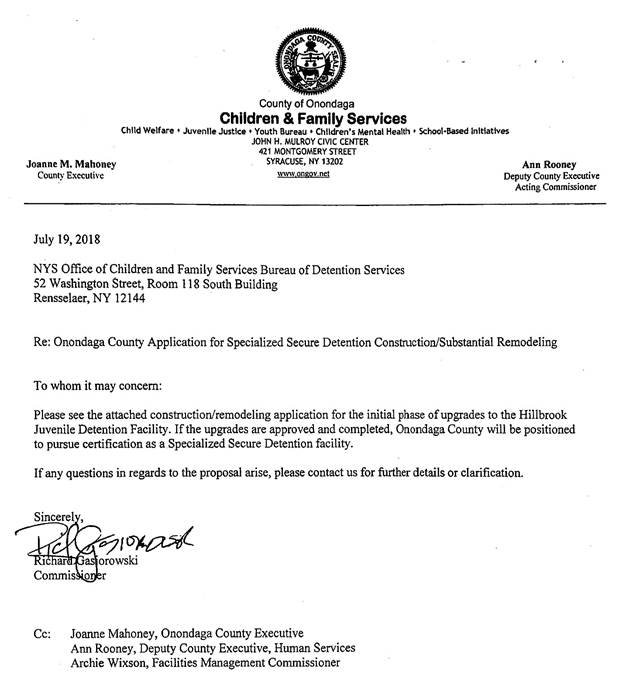
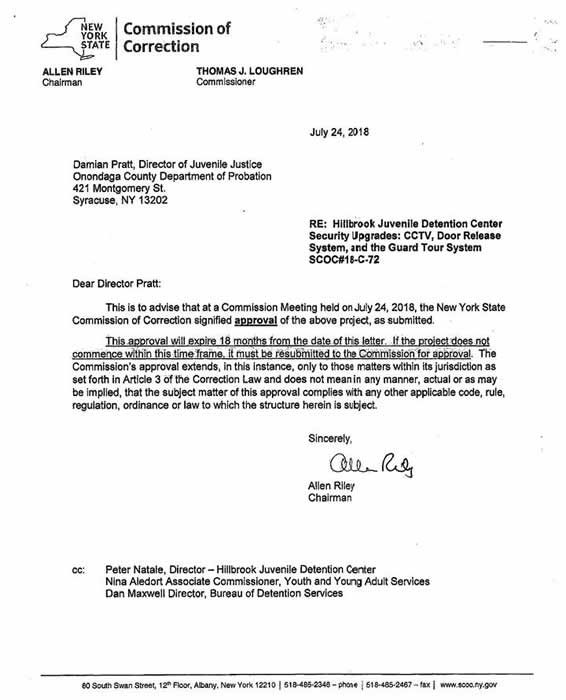
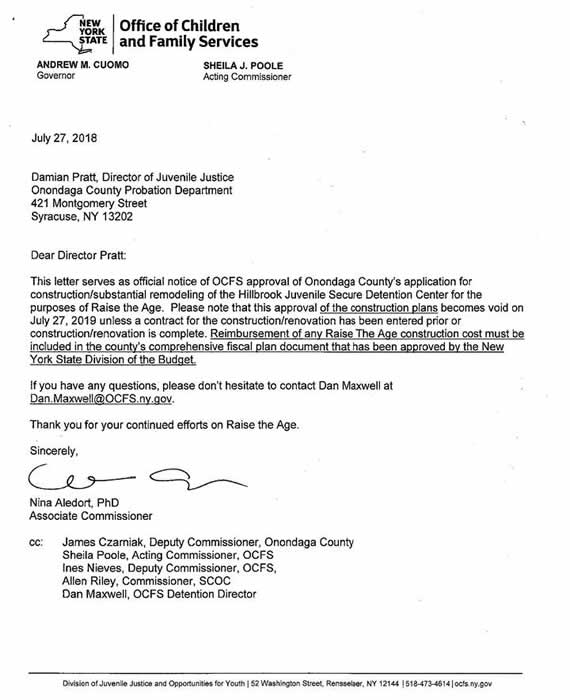
Ms. Rooney responded to Dr. Chase that healthcare is already provided through the contract people.
Mr. Jordan asked if the approval of the plan is in reference to the additional improvements the County will be making, or improvements that are already made. Ms. Rooney clarified that the letter is for improvements already done. The plan is the more expansive plan involving the Department of Probation, the Department of Children and Family Services, the District Attorney (DA), the Law Department, the Sheriff’s Department, the capital improvements, and the state asking the County to be an anchor County.
Ms. Rooney replied to Mr. Bush that these are additional positions.
Ms. Rooney:

-
County plan state is requiring; last piece is explanation of numbers; breakdown of County totals on first page
-
State fiscal year is different than the County’s; numbers in budget starting January 1st; Jan. – Dec.; April 1st – March; incorporating October – March; then 2019 starts April 1st; budget years get confusing; budget will reflect it
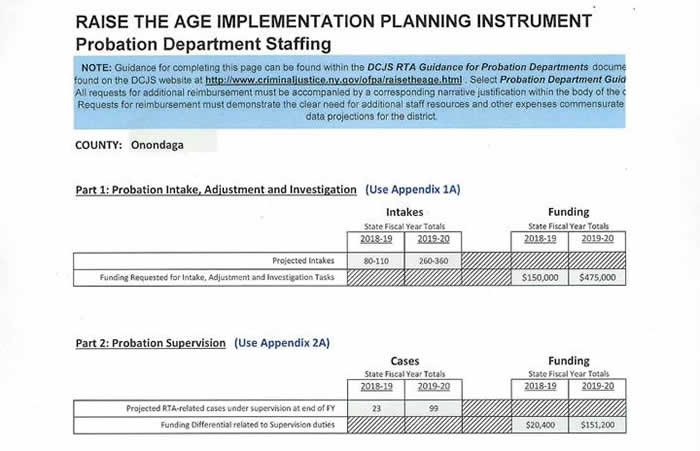
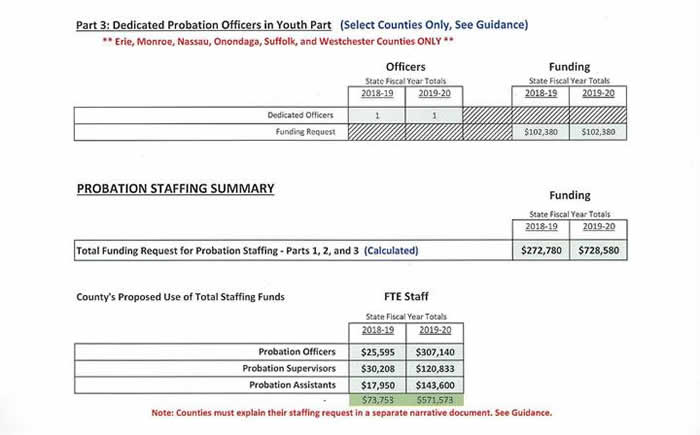
-
Probation segregated where youth Probation Officers work in Department of Children & Family Services; on adult side there are alternatives to detention they will implement
-
Spreadsheet shows how many young people (16 and 17 year olds) are now brought into family court; how many Probation Officers will be needed
-
2018-2019 budget year - requesting from state $74,000; quarter year of staff, because they will start in October of this year; covers Probation Officer, Probation Supervisor, and Probation Assistant
-
2019 – 2020 (past 2019 budget year) calls for 3 fulltime Probation Officers, a Supervisor and 2 Probation Assistants – because of additional case load of having 16 and 17 year olds through Family Court; more alternative work
-
Probation Officers creation of positions will be in the budget; these are what is needed prior to the 2019 budget
-
Some positions will be asked for creation at time of budget to have time prior to Jan. 1st to do canvasing; will not be hired prior to Jan 1st
Mr. Jordan said that currently the County has Probation Officers handling potential juvenile offenders, and with Raise the Age, the age of criminal responsibility has increased. There are still Probation Officers addressing what are now not juvenile offenders. Mr. Jordan asked why should there be an increase in staffing, when they can move the ones that are handling the lower adult age. Ms. Rooney believes Mr. Jordan is describing the difference between Family Court and Criminal Court. Many times the first stop for a young person would have to make is probation intake, and they may never open a case with alternatives to detention. Working with youth and families to divert them from coming into the criminal court system. A tremendous amount of work is done prior to sentencing on the youth side. On the adult side, someone is given a Probation Officer, because they were sentenced. This is prior to any judication on the youth side. Mr. Jordan said there are defendants released to be monitored by Probation Officers on the adult side, and their caseload will decrease, because they will not be dealing with as many adult offenders. Ms. Rooney stated they looked at what caseload they are anticipating, and the number of cases. Probation is the only form the state filed out, and they thought the County would need staffing at 728,000. Ms. Rooney said they brought it down to 571,000.
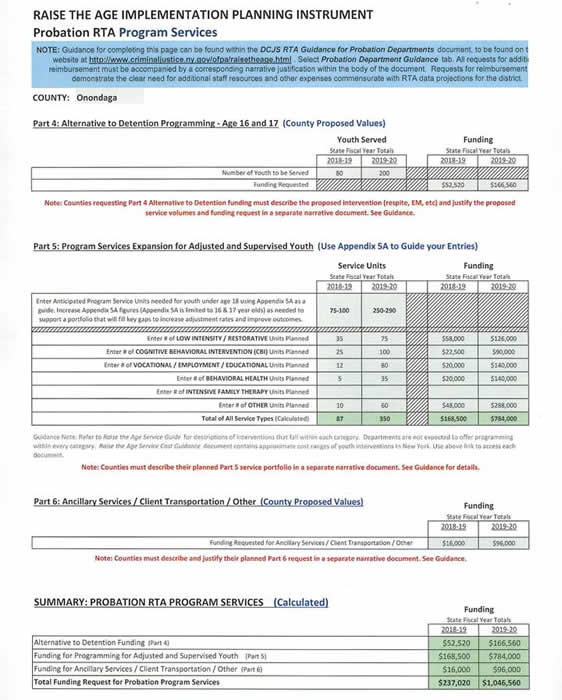
- Alternatives to detention; contracts use; what they currently do for youth under 16 years of age
- Anticipated caseload – looking at 200 youth planning to be serviced in 2019/2020, and plugging in services to be provided to come up with $237,000 in 2018/2019 and $1.46 million in 2019/2020
- Also included education, advocacy, client support, bus passes - anticipate those numbers
Chairman Buckel asked why family therapy is blank. Ms. Rooney replied that the County does not use that here, because they have FFT; Functional Family Therapy. Dr. Chase asked where the FFT comes from. Ms. Rooney responded it would be under behavioral therapy and cognitive. Dr. Chase said it does not seem like a lot. Ms. Rooney explained that it is based on what they are using on the youth side now.
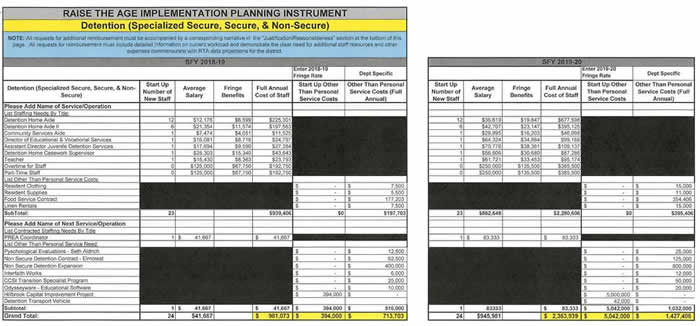
-
County is 1 of only 6 detention facilities outside NYC; $5 mil in approved for anticipated improvements for Hillbrook under Capital Improvements
-
2018-2019 start up, other than personnel services, costs at $394,000 – Legislature approved with last year’s capital expenditures that has been sent in for reimbursement (reference the previous letters)
-
All this is ramping up of staff – what is in this resolution is in there, and the additional staff in January
-
100% reimbursable; covered all costs anticipating
-
State anticipating Onondaga County will serve as hub county for other counties requiring detention for youth
Mr. Bush asked if the County gets reimbursed for being a hub. Ms. Rooney replied:
- Right now the County gets 100% reimbursement for out-of-county youth; that will continue
- Helps pay for County costs; every year finance staff calculates daily rate to cover all costs; daily rate is charged to other counties, and reimbursed 100%
- Right now legislation reads that the County receives 49% reimbursement on in-county youth; any young person in the facility under age 16 is reimbursed 49%; any youth 16 or 17 is reimbursed 100%; works out to bring 49% to ~75%
Ms. Rooney responded to Mr. Jordan that the out-of-county youth reimbursement includes the County’s share of capital costs.
Mr. Rowley said the $394,000 under capital improvements was last year’s amount, and asked what the $400,000 in the next column is. Ms. Rooney responded:
-
Detention facility capable of housing 48 young people, which includes AO’s (16 and 17 year olds), Juvenile Offenders (accused of committing very serious crimes), and Juvenile Delinquents
-
Thought is that any Juvenile Delinquent housed at Hillbrook should not be in a secure setting; this would allow for having them housed at (i.e.) a cottage at Elmcrest
-
Would also allow for bringing in more out-of-county kids; expand the footprint beyond the 48
-
Having young person in lock down facility not a good precipitator for that youth; would be better for them to be at a place like Elmcrest, and move through system that way
-
Have non-secure contract with Elmcrest at Skeele Valley in Tully; current contract is 1.5 beds per year, because it is not used that much; contemplating increasing to 4; this will also house young people from other counties
-
Right now it’s reimbursable at 49%; this will be 100%

-
Costs incurred by Sheriff’s Department with transport, Law Department for legal services
-
Any youth charged with serious offense (i.e. gun charge, sexual offense) will be screened first by District Attorney’s office; DA will make decision whether case should go to youth part; DA will guarantee a DA will sit in youth part
-
It includes Assistant DA costs; charging for financial ops
- All of this encompasses “all other” around Raise the Age
Chairman Buckel said it is an aggressive and thorough compilation of associated costs, and asked if this was part of the initial plan given to the state. Ms. Rooney said they have not given this to the state, and the state gave the County the template to be completed. Ms. Rooney agreed with Chairman Buckel that they are confident this is within the scope. Ms. Rooney stated they already get reimbursement for a lot of this, but not at the 100% level.
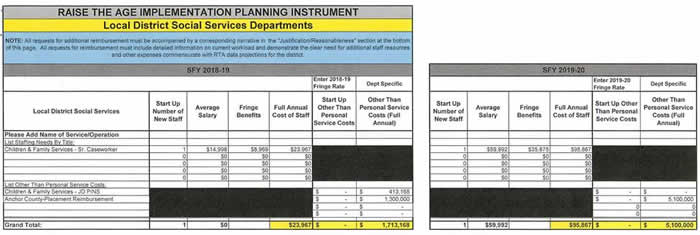
-
State asked Onondaga County (and others) to be an anchor county; state cannot contract w/local placement agencies
-
Will be reimbursed for staff costs; $5.1 million a pass-through; state has to know there are beds for placement; asking County to sign contract, and will pass money through
-
Spirit of cooperation on County’s end; if more cooperation with state, then more giving County things like rapid response in a week; looked at favorably because of cooperation
-
In agreement – if County does not receive reimbursement within 30 days, then have right to terminate contract immediately; ensure County not left holding the bag; not ongoing costs for County
Mr. Bush asked for clarification that Raise the Age is not going to cost the County taxpayers any money. Ms. Rooney answered that at this point yes, that is correct. It is way the legislation is written. Mr. Jordan is concerned that the state is saying yes now, but that it may change when the state has issues. The next thing is that the local taxpayers are carrying the burden. Ms. Rooney said:
-
If 5 years down the road, reimbursement went from 100% to 75% and County has not done these things internally, then County will not get reimbursed 100% from other counties; it will also be more expensive to send youth somewhere else
-
State is already seeing a shortage of beds
-
County cannot control court system when judge says they are going to Hillbrook or another facility; still have to pay
-
Estimation – makes most sense to keep youth close to home, and reap benefits of other counties paying the County’s costs, which are fixed costs
Chairman Buckel asked if there is anything in the contracts that would give legs to Casey (Jordan’s) concerns. Chairman Buckel’s understanding is that the risks the County would have in the future is that the reimbursements will be subject to the appropriations of the Legislature. It is possible that the Legislature could refuse to appropriate funds. Mrs. Tarolli asked if he’s referring to the New York State Legislature, and Chairman Buckel said yes. Mrs. Tarolli explained that any contract with the state has an appropriations clause. Anything is possible, so there are discussions to give a comfort level with the budget numbers.
Dr. Chase asked what the Detention Home Aide qualifications are. Ms. Rooney said they have to have a high school degree, and have worked with youth for six months in some capacity. Ms. Rooney agreed with Mr. Bush that it is minimal, but they go through extensive training. Mr. Bush asked if it is on the job training, and Ms. Rooney answered no. Prior to ever working with youth, they go through an extensive training cycle.
Mr. Bush asked if there is a chart to show a novice the age brackets, what crimes require this or that, etc. Ms. Rooney said yes. There is a spreadsheet that covers all of this. A few years back, they found that families needed to understand it all. “If this, than that.” Ms. Rooney will get copies to the committee. Mr. Jordan said if a child is classified as a juvenile delinquent, then they’ve been through a process with all obligated services offered to try to avoid that determination. Mr. Bush understands the benefits and goals of what is being done, but he is confused about the steps.
Ms. Rooney stated when they came last month for a capital request, they did not include the SEQR. That will come next month.
Chairman Buckel stated that Chairman May of the Ways and Means Committee wanted to point out that the third whereas states that the personnel changes have been authorized when approved by the Ways and Means Committee. That has not yet taken place. To avoid drafting different versions of the resolution from inception to the legislative vote, it was written this way.
For the record, Chairman Buckel moved to let the record show that replacement 1a is amended to show that the Ways and Means Committee has not yet considered or approved this resolution. Mr. Jordan seconded the motion. Dr. Chase asked if the language could be changed to read, “upon the authorization by the Ways and Means Committee.” Chairman Buckel conferred with Mrs. Tarolli, who agreed it is ok to let the record reflect that language.
A motion was made by Mr. Jordan, seconded by Mr. Rowley, to approve the amended resolution. Passed unanimously; MOTION CARRIED.
A motion was made by Mr. Rowley, seconded by Mr. Jordan, to adjourn the meeting. Passed unanimously; MOTION CARRIED.
The meeting was adjourned at 10:45 a.m.
Respectfully submitted,

JAMIE McNAMARA, Assistant Clerk
Onondaga County Legislature
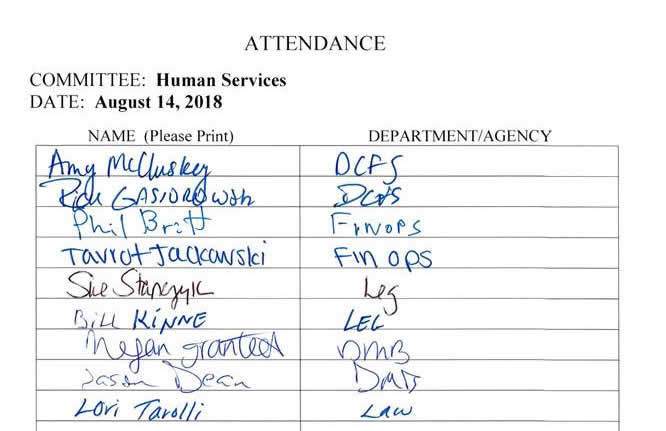
* * *
ENVIRONMENTAL PROTECTION COMMITTEE MINUTES - AUGUST 15, 2018
MICHAEL E. PLOCHOCKI, CHAIRMAN
MEMBERS PRESENT: Mrs. Tassone, Dr. Chase, Ms. Cody, Mr. Burtis
ALSO ATTENDING: Chairman McMahon, Mr. Knapp, Mr. Bush; see attached list
Chairman Plochocki called the meeting to order at 9:10 a.m. A motion was made by Mrs. Tassone, seconded by Dr. Chase, to waive the reading of the proceedings from the previous committee; MOTION CARRIED. A motion was made by Mrs. Tassone, seconded by Dr. Chase, to approve the minutes from the previous committee; MOTION CARRIED.
Chairman Plochocki stated that a few informational items will be inserted between items 1a and 1b.
1. WATER ENVIRONMENT PROTECTION: Tom Rhoads, P.E., Commissioner
a. Authorizing the County Executive to Enter into a Contract with the United States Department of the Interior for the Operation and Maintenance of Stream Gaging Stations in the County of Onondaga
Mr. Roads:
- Annual renewal, ACJ requires steam gaging – measures the amount of water going into and out of the lake through various tributary points
- USDIO continues to decrease their portion of the cost-sharing, now 65% local and 35% federal, county’s share $96,920
- Efforting the removal of several gaging stations in the future as not all stations relate to combined sewer overflows, i.e. Nine Mile Creek
- Part of the regular operating budget
Chairman Plochocki reiterated that this is required, and an agreement with the Department of the Interior (DIO) is the most cost-effective way to go. Dr. Chase questioned how the DIO was able to reduce their share. Mr. Rhoads responded that their mission is to reduce the federal spend and this is one way in which they do it. In answer to Mr. Burtis, Mr. Rhoads confirmed that there is no additional impact to the 2018 budget.
A motion was made by Mr. Burtis, seconded by Dr. Chase, to approve this item. Passed unanimously; MOTION CARRIED.
2. INFORMATIONAL: OCRRA
Chairman Roads introduced Dereth Glance as the Executive Director of Onondaga County Resource Recovery Agency (OCRRA).
Ms. Glance:
-
Update on waste and recycling
-
Waste to Energy Plant testing - conduct more tests on more parameters every 5 years, will forward an abridged graph (see attachment 1) contains 5-year and annual data, pay special attention to the 24-year history, the average, and where we are this year, trends continue to get better and better
-
24-year-old plant is operating better than ever, $15 million dollars’ worth of improvements that include enhanced scrubber and technology, optimizing those technics; 10,000 tons of metal recovered annually through that process - not all can go into the blue bin, a critical recovery of resources for electricity, reduces the volume of waste going to the landfill and recovers metal that would otherwise be buried forever
-
Fall newsletter to be delivered via the Eagle and Post Standard newspapers in early September, centerfold will include full graph
-
Moving onto recycling markets -governor issued a press release yesterday, China’s National Sword program has significantly impacted the overall recycling market
-
Blue bin items have changed since the start of recycling due to consumer habits, i.e. daily newspapers, 50% of blue bin weight is now mixed paper, have local markets for plastics, metal, and cardboard but 50% of the entire global market for mixed paper was controlled by China; over past decade slowly reduced prices driving all the paper to their market, shuttered domestic mills, now have very little capacity
Chairman Plochocki stated he was shocked to learn that 50% of the aftermarket paper went to China, and asked Ms. Glance to briefly discuss why the paper is no longer wanted. Ms. Glance responded that when countries are looking to build their industrial process they will often suffer through more pollution than when incomes go up and people are more comfortable. This is what we are seeing with China, where they have incredibly awful smog rates. A similar depression was seen during the Olympics when the paper mills where shutdown so that people could breathe and the air quality would be better as they don’t’ have the same strong environmental controls. They are now going in that direction and we see this as a real depression with significant global implications. The experts anticipate it will take 12-24 months to build capacity, improve the sorting process for paper, and develop domestic markets for paper processing.
-
Recycling is not dead, significant depression; metal will be up and down, tariffs are confusing the metal market, not worried about metal overall due to domestic capacity, not worried about plastics as much, have domestic capacity but a lot goes out of the country, have a reliable market to move the material
-
Communities in northwest unable to move paper right now, don’t think we have hit the paper crisis bottom; actively working with the governor and other planning partners in the region to determine the best strategy to move forward
-
Caused significant issues for OCRRA, which is an enterprise fund responsible for finding revenue sources to cover its bills; contract with Waste Management (WM) to manage all blue bin material, had long-standing contract, just renegotiated fantastic contract but there was a force majeure clause - when markets are consistently poor for 3 consecutive months WM has the ability to exit the contract, contract provided OCRRA a maximum exposure of $370,000 per year, the amount OCRRA would pay to help insulate when markets were bad, received written notice WM will be exiting the contract as of Oct. 31, 2018, working on renegotiation and determining the direction in which OCRRA wants to go; won’t have the protection of maximum exposure, an important piece
-
Things change quickly, last year OCRRA gained a little over $125,000 as part of the revenue sharing agreement, markets were better; have seen things go up and down but this will be a depression because the paper is such a large part of the volume and there are capacity issues
-
Opportunity to make things even better, should be manufacturing things in our own country from the blue bin paper, make it a priority to work with both the virgin timber industry and other paper manufacturing, great increases in technology are available, optical sorters and scanners can divert high-quality office paper just requires infrastructure investment; OCRRA is in the budget process, board is grappling with this, wanted committee to be aware
Dr. Chase asked if it could come down to not putting paper in the blue bin. Ms. Glance responded that we have spent close to 30 years telling people what goes in the blue bin. Onondaga County has one of the lowest residual rates of any community, and these materials continue to have value even if the markets are depressed because of a lack of real-time capacity. We want to continue the practice and use this as an opportunity to make recycling even better. It is just going to take some money, time and patience. Now is the time to walk away from recycling as those are really critical materials.
Chairman Plochocki asked where this is going in terms of costs to OCRRA and its customers. Ms. Glance responded that there is a variety of ways in which we can deal with resources. OCRRA is the implementer of the Onondaga County’s Solid Waste Management program; County of Onondaga is the planning unit, OCRRA does the work on their behalf, tied directly to the county. Our programs have been funded typically through revenue tipping fees of the Waste to Energy Plant and electricity revenues. When Mr. Rhoads ran OCRRA they had $20 million in the bank and a guaranteed 6.5 cents per kilowatt-hour for generated electricity. That is now gone, the electric revenue used to comprise 38% of OCRRA’s budget and now is about 12%. It is a huge hit and we end up putting more pressure on the tip fee.
-
Garbage is a utility experienced differently by all, i.e. City of Syracuse resident can put out 3 tons of garbage a week and see no difference, some people are charged per container, tied to taxes for others, depends on the community; working with the County to look at each individual community contract, question if this the best way to do this, i.e. pay to be part of the water system, then pay for the amount used, encourages conservation; questioning if there a smarter way to structure the entire program so that people feel what garbage is, nothing will change in short-term, must adopt a budget in October
-
Can also increase the tip fee, large hauler contractors paying about $85 per ton, looking at $10+ increase just to break even this year; OCRRA has been very conservative, haven’t filled many positions, bare-bones staff
-
$2.5 billion deficit (*See Revision Below) looking at a variety of ways to fill that hole, most reliable is the tip fee, not entirely sure that is the best way; grappling on this, the board has done large-scale big picture budget issues, committee meetings start today and go through September, hard decisions will be made
* 9/5/18 Ms. Glance asked that the record be revised to show the deficit as $2.5 million.
Dr. Chase asked what kind of impact $10 per ton would have on a trash day, i.e. for Dewitt. Ms. Glance responded that in general there is about 270,000 tons of MSW generated per year, so every dollar is about $270,000.
-
Onondaga County has an award-winning recycling program, much to be proud of, in really good position, may have an opportunity to make it even better; update provided so that legislators aren’t shocked
Chairman Plochocki thanked Ms. Glance for the update. Ms. Glance thanked the Chairman and said she would follow up and is always happy to help if there are any other questions.
3. INFORMATIONAL: Wastebed B/Harbor Brook State Superfund Site
Chairman Plochocki:
-
Clarification on the lake cleanup, people are focused on water cleanliness, i.e. can you swim in it, can you drink it, is it poisonous, does it smell
-
Honeywell has focused on the soil at the bottom of the lake, we focused on the water itself per se, often forgotten by the public and newspapers is the lake shoreline which is an extensive amount that must also be remediated; when the newspaper says the main cleanup is done they are referring to the lake water and bed itself, many things around the shoreline are still a work in progress
-
Honeywell work will continue on the shoreline in the coming years, know what the work will be in some cases, have other areas where the remedy has not determined but the DEC will ultimately make that call
-
After research and study with various groups the DEC periodically releases a draft proposal for the next section of cleanup, released factsheet for proposed remedy of Superfund site located on the west side of the lake, south of the amphitheater, down to Metro; the trail has already been planned for a portion of the area, while nothing has been finalized for other areas
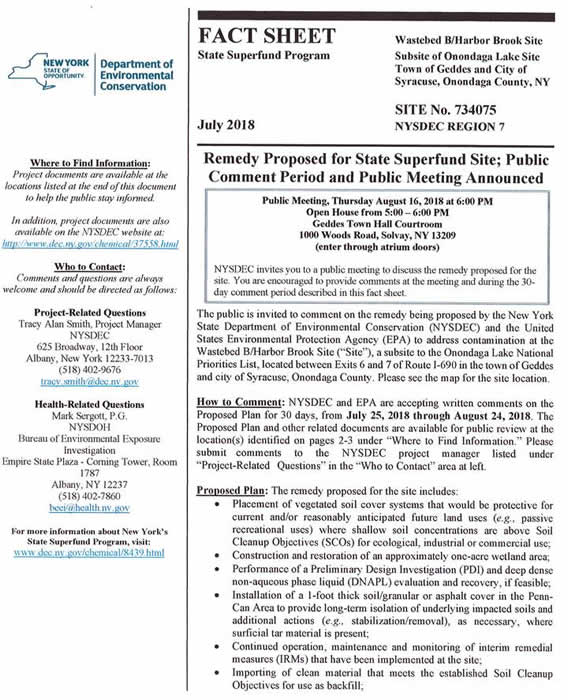
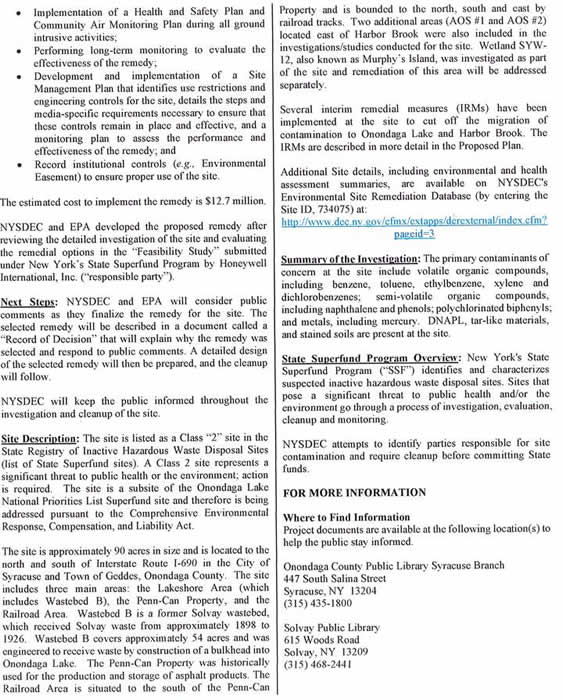
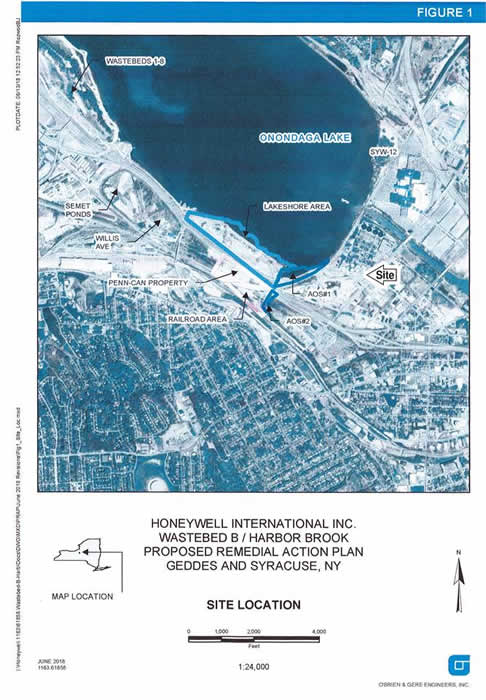

- County has zero input, DEC considers the county to be one of the polluters
- Dr. Chase and many legislators may have received a letter from the Law Office of Joseph Heath
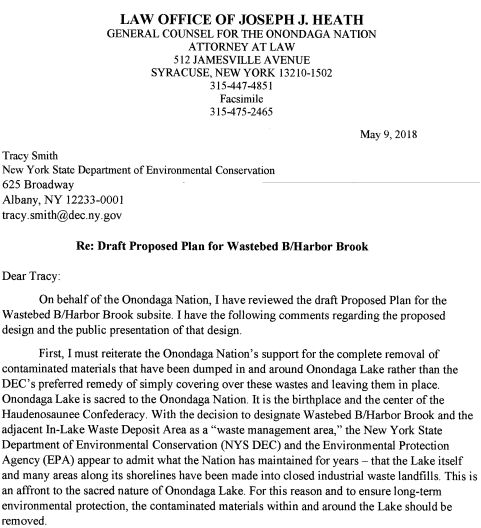

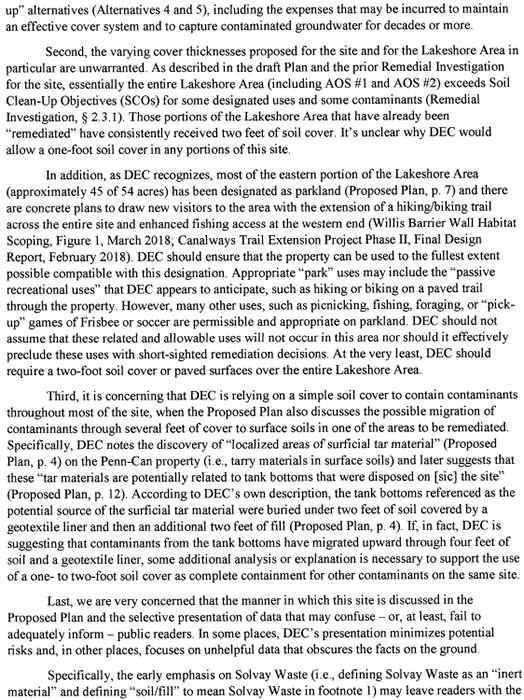
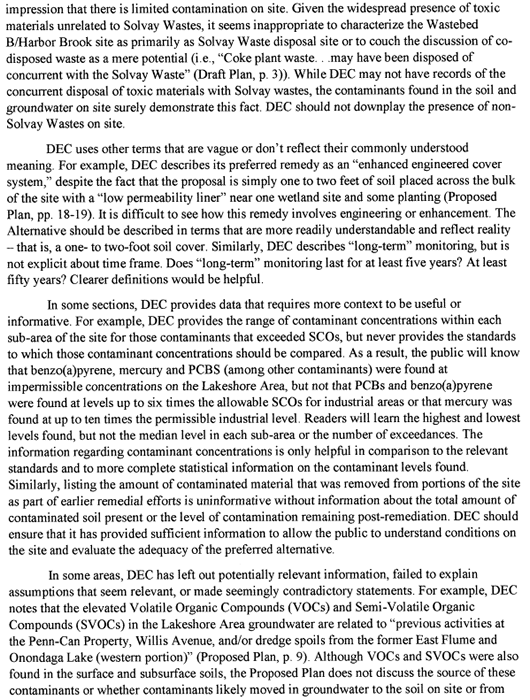

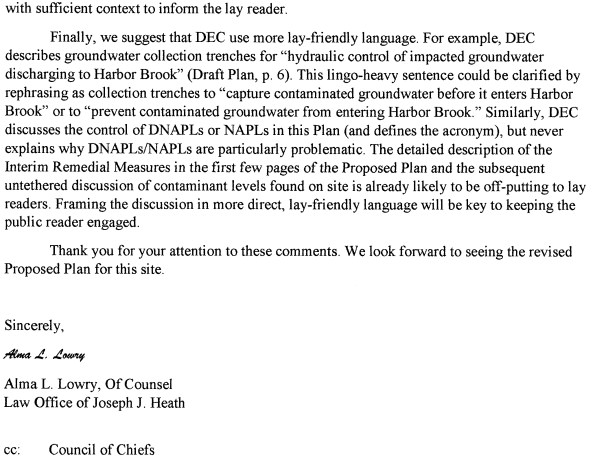
-
Mr. Heath is the lawyer for the Native Americans, specifically the Onondaga Nation; they are not official parties but believe the DEC plan is terrible, as do many other environmental groups in the area, in general, these groups have never been happy with any stage of the cleanup; wanted everyone to be aware
4. INFORMATIONAL: Algae Bloom
-
Hoped last year’s outbreak was entirely special circumstances and there would be no further blooms; 2 sets of blooms already this year, north end and near Lourdes Camp
-
Current debate as to the level of harm and toxins present, in an abundance of caution there have been closings and more chlorine has been added to the City of Syracuse water intake at the north end of the lake; most recently Lourdes Camp, located on the southeastern portion of the lake, shut down for the first time in its 56-year history, draws water directly from the lake and doesn’t have the water treatment level of the city
- Last year much of the lake was 1 large bloom, this year the 2 blooms are far apart from each other, could change, there is evidence of some dissipation
Dr. Chase said that this morning Mr. Rhoads told her the bloom is not toxic. Mr. Rhoads clarified the Lourdes Camp bloom is not toxic. Chairman Plochocki said that none the less, these blooms spook us and we would rather see fewer than more. Dr. Chase said that a small committee has people collecting daily water samples from various sections of the lake, 30-40 people are committed to this. There have not been any problems aside from the issue in the village. Everyone gets spooked when they see these but they are not all toxic and they are everywhere. We worry about it because it is our water source but other waterbodies around us also have them. We should be worried about all waterbodies and what makes them toxic. Ms. Cody said that Jamesville also had several. Dr. Chase said that Otisco also had them where people are in the water all the time and some drinking water is pulled from there. Skaneateles is not the only lake with a problem, and Owasco Lake has been a problem for a while.
For the record Chairman Plochocki said, “In dealing with this problem obviously many governments are involved from the state, to the city, to us.” Chairman Plochocki added that Dr. Chase, government officials, engineers and himself have been meeting with groups in the Skaneateles area. In particular, he has been consulting with the Skaneateles Lake Association members. The bottom line is that the county is remaining very active on this issue.
b. A Resolution Calling a Public Hearing in Connection with Proposed Improvements for the Onondaga County Sanitary District for the Meadowbrook-Limestone Wastewater Treatment Plant ($9,000,000)
Mr. Rhoads:
- 2 remaining items on the agenda are related

- Plant seeing more flow even as population and water consumption decreases – symptomatic of extraneous flow
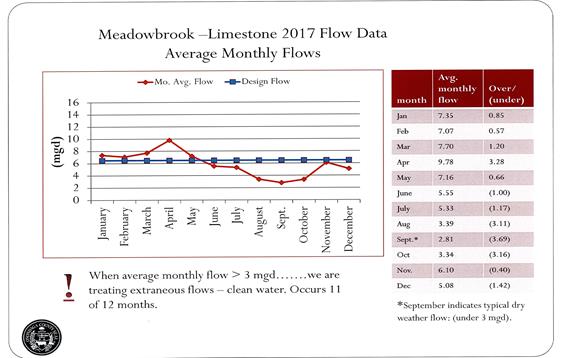
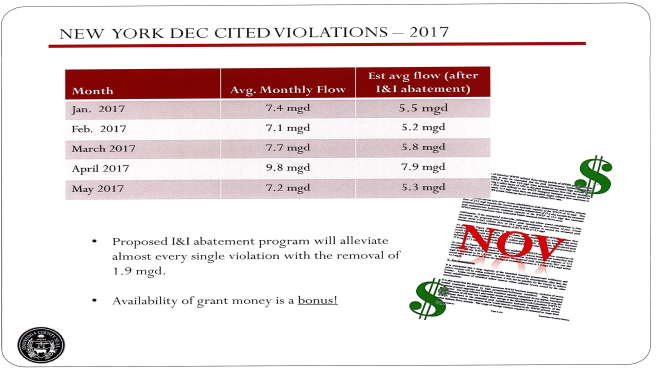
-
Received permit violations from NYS, now received a notice of violation from the early part of 2017, had similar experience in the early part of 2018 – ongoing monthly violations of more than 2 quarters places on you the EPA radar, which means the DEC is pursuing a notice of violation with intent for there to be a consent order to require the situation to be remediated; silver lining - grant funding is available
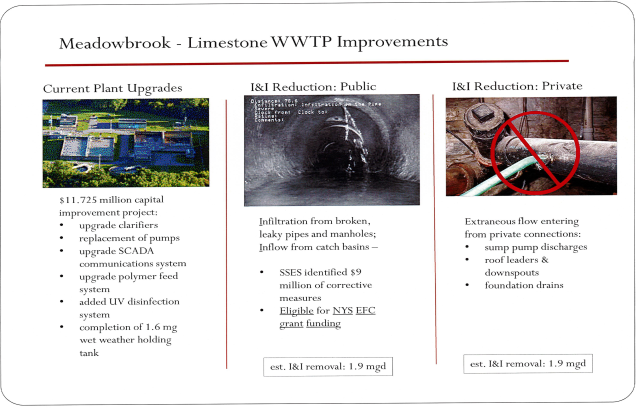
-
Current plant upgrades will help with the efficacy of treatment in wet weather
-
Now approaching the Sanitary Swear Evaluation Study (SSES), the center image above (see pg. 12) shows the inside of a manhole with extraneous flow showering down, typically groundwater infiltrates the swears, when groundwater and rainwater tables are high we have an extreme amount of infiltration and extraneous flow
-
Miles and miles of sewers are owned by others; are talking about doing work in municipalities owned by others, makes things more complex, believe $9 million cost will remove about 1.9 mgd, also believe 50% of the extraneous flows are related to illicit private connections, i.e. sump pumps discharging into the sanitary system can be equal to 18 houses, have dramatic and ongoing effect, roof leaders, downspouts, and foundation drains also contribute to private source I&I; preview of coming attractions, want to revisit how we educate the community and perhaps address things further with local law 1-2011, which involved enforcement and the capacity to require removal of illicit connections
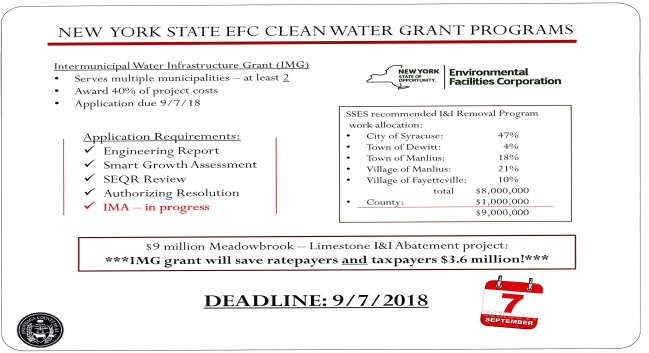
-
Proposal coming together in a hurry; IMG grant requires 2 municipalities, would have 6 including the County, no better grants available for this sort of infrastructure, 40% state dollars, 60% local match
-
Package has several flexibilities, engineering report is being drafted, talking about doing restoration work with term service contracts already available, need authorizing resolutions and IMA
-
Requesting approval for public hearing resolution, $9 million dollar County led project; percentages preliminary and subject to change, cost-sharing arrangement not listed in the IMA, drafted to meet the requirements of the grant deadline, hope to have success in obtaining the grant, will come back with specifics of the cost sharing in the near future, efforting that all these municipalities draft a resolution to enter into an IMA and allow the County to be the lead agency, apply for this grant and revisit the cost-sharing arrangement; advancing in quick fashion to save taxpayers $3.6 million
-
1b calls for a public hearing in connection with the proposed agreements and 1c allows the county executive to enter into IMA’s; same generic IMA document provided to the other municipality simply changing the name of the municipalities and mayor
Chairman Plochocki said that Mr. Rhoads did a great job with this complex situation. However, he wants to highlight the some of the complexities to be sure everyone is on the same page. All the water that ultimately flows through county pipes and into county WWTP’s doesn’t necessarily start out in county pipes. If he could go back in history he would ring the necks of county officials who started the process this way. Often the county would agree to take on wastewater from an existing system but did not buy or lease the pipes. This system can be a nightmare when it comes to repairs and other things. What is happening now is just the tip of the iceberg. Think of this as a spider web with the center of the web being Onondaga Lake, where Meadowbrook-Limestone and many of our plants empty into. In the immediate first portion of the web are our pipes, plants, and system but the external pipes around the fridges are owned by others. Because all this outside water goes through our pipes, even if the county owned pipes were in perfect condition and our plants were operating at perfect efficiency we would still have a problem if there are problems in the outer system because there are no financial consequences to the municipalities for having leaking pipes. The fact is their water goes to the county, which was already agreed, and they don’t pay anything for it. When you combine this with the problems of our own system there is a real issue. Secondly, because all the water flows into Onondaga Lake we are required to maintain a certain level of cleanliness and it is more difficult to effectively treat when we have overflows. It is now to the point where water coming from Meadowbrook-Limestone is under a consent order. In short, the state is saying we must fix the problem from this source. If we don’t we will be heavily fined and still be required to fix the problem. Mr. Rhoads corrected that this goes into Limestone Creek, and eventually Oneida Lake, where we also spend a lot of money. Chairman Plochocki thanked Mr. Rhoads for the correction and noted that he should have been clearer in his model. There are two interconnected spider webs, with two center points, and the pipes determine where things will go but the analogy still holds up. Thirdly, we normally work with clear numbers. In this case, we need to get the ball rolling fast to meet the grant deadline and IMA’s are required. There is a huge incentive to fix this problem and we believe we have a good shot at getting this grant. The first vote would be to authorize the public hearing and the second vote would authorize IMA’s, without everything solidly fixed, to show good faith that municipalities are will to work with us. Chairman McMahon stated that we are working collaboratively with these partners to determine the best way to move forward. Our underground infrastructure is in real trouble and we don’t own a lot of it. This needs quick legislative action as we have a good opportunity to try and obtain a grant that would cover 40% of the costs.
Mrs. Tassone questioned how far long the $11.7 million project was, adding that it was scheduled for completion in May. Mr. Rhoads responded that UV disinfection came online in time to meet the SPDES permit requirement. The clarifier improvements are ongoing and will likely end in November 2018. Mrs. Tassone questioned if there would be any funds remaining. Mr. Rhoads responded that he did not want to guess. The project has had several challenges – it is roomy but he’s not sure it is that roomy; can get back to that in the future.
Mrs. Tassone said that we have to authorize $9 million in order to apply for the grant. Mr. Rhoads agreed. Mrs. Tassone asked how long the project would take and if they would come back for more money. Mr. Rhoads responded that he cannot guarantee $9 million will satisfy the DEC’s appetite for new pipes, tanks at the plant and everything else. The project will likely be 4-5 years. The state would like to see $20-$30 million dollars’ worth of additional storage or tanks at the plant. We are resisting, “when the bathtub is overflowing you don’t run and get more buckets to store the water, you turn the water off.” We need to stop the extraneous flow and measure how much has been reduced before we talk about additional storage. Currently at an arm’s length in bargaining with the DEC as to where they are going with the consent order, a full-on discussion.
Mrs. Tassone asked who came up with the $9 million amount. Mr. Rhoads responded that an SSES study competed in 2002 identified $5.2 million dollars’ of work. The flows were again measured in 2016-2017. None of the work identified in the 2002 study was completed but for the work that the County completed or paid for via grants to municipalities. With the current contracts and the amount of flow seen in 2017 GHD engineering proposed $9 million to get after the leaking pipes, manholes and illicit connections from catch basins. We are currently lining our Meadowbrook sewer and found 22 catch basin connections which were removed, even after municipalities told us that none of their catch basins were connected. Chairman McMahon stated that we could have an answer that meets the DEC’s goals today but 4 years from now infrastructure 5 blocks over could start doing the same thing. The real problem is that there has been no investment by these other municipalities. It is difficult for them as there is not a lot of money in their budget and they have a property tax cap. Chairman Plochocki noted that before Chairman McMahon arrived the lack of incentive was discussed and the fact that a consent order to the County doesn’t immediately affect them. Chairman McMahon said that eventually it would be passed on but this goes to the bigger picture of how we operate the system and what the ownership should be. A long-term strategy, and how to fund it, needs to be worked out with our other partners in the towns, villages, and city.
Dr. Chase questioned this year’s flow. Mr. Rhoads responded that flows are similar to 2017 with violations through the first half of 2018 as well. Dr. Chase said that we are now dealing with the violation from April 2017. Mr. Rhoads responded that when a notice of violation is thrown down it includes everything that was ever done wrong. Dr. Chase said the biggest problem happened in April 2017 and now they want us to have a plan by September. Mr. Rhoads responded that this is how consent orders work, they want to know exactly what will be done and you commit to doing it under penalties of law.
In answer to Mr. Burtis, Mr. Rhoads said that the DEC has not yet imposed a fine but has the ability to assess a penalty of $37,500 per day. Chairman Plochocki said they could also impose a lesser fine. Mr. Rhoads said their cover letter includes the possibility of fines. They are working with us but are asking that we don’t sit on our hands for another 15 years.
Mr. Burtis said the overall work allocation is $8 million and questioned what the County was paying $1 million for (see pg. 13). Mr. Rhoads responded that it would be for investigations within these tributary areas. We studied the flows from these large tributary areas but will now get into the precision of which pipes provide the best bang for the buck. Mr. Burtis said that the county would be contributing a flat amount and not a percentage. Mr. Rhoads agreed, adding “all of that is still to be wrung out in the wash.” Mr. Burtis asked if there was any idea what the future impact would be for the budget beyond 2018. Mr. Rhoads responded that the worst case scenario would borrow $5.4 million via a 20-year bond, but at least we would be somewhat money ahead. Frankly, we are looking for some real contributions, and are talking with the state about joint permits whereby there would be permit responsibility on the municipalities. Chairman Plochocki said that this would give them an incentive since they are the owner of the system. Dr. Chase said that it is more than an incentive, they would be responsible. Mr. Burtis said that 47% of the work will be done in the city and “they don’t have dollars, they only have quarters.” This is a real concern. Mr. Rhoads said that we are the ones on the hook right now. Mr. Burtis asked if the $3.6 million IMG grant savings was cooked into the numbers. Mr. Rhoads responded no, $9 million would be the amount we are applying for and success with the grant yields 40% - $3.6 million.
-
This is a work in progress, appreciates their patience; Commissioner’s public hearing held last night, for the 1st time in 20 year memory had attendees, 2 Manlius town board members, the Town of Dewitt supervisor and 5 other residents; believe there will be a community discussion on this
-
Will return with future resolutions, talk about brass tacks and get into borrowing
Mr. Burtis questioned how they would get everyone to come together and contribute. This situation is similar to his and his college son’s relationship - his son has some money but wants to keep it and pleads poverty. Chairman Plochocki said that Mr. Rhoads is front and center in the negations but there are also other government officials talking on the county’s behalf. Fundamentally, Chairman Plochocki agrees that it will be especially hard to get much of a contribution from the city. That being said, some elected officials and others are interacting with the municipal leaders in hopes of getting a better response, actual results are to be determined. Ms. Cody asked if that part had to be determined before September 7th. Mr. Rhoads responded that IMA’s are required but it does not require the breakdown. Chairman Plochocki said that we would really like to have the numbers by then. Mr. Rhoads stated that his best guess is that this will need to be boiled down by the beginning of the 4th quarter. Ms. Cody said that this is coming up very quickly. Chairman Plochocki said that this is an unusual situation and, for all the reasons explained, we don’t want to lose the opportunity for getting this grant. This is literally millions of dollars. Mr. Rhoads said that all the IMA’s are not required to apply for the grant, need at least two, which is what they are working on for the application.
A motion was made by Dr. Chase, seconded by Mrs. Tassone, to approve this item.
Chairman Plochocki stated, to be clear, this for item 1b - calling for a public hearing.
Passed unanimously; MOTION CARRIED.
c. Authorizing Execution of Agreements with Cooperating Municipalities in the Meadowbrook-Limestone Service Area to Apply for Funding Through the New York State Intermunicipal Water Infrastructure Grants Program and to Collaborate in Implementation of Such Grants
A motion was made by Dr. Chase, seconded by Ms. Cody, to approve this item. Passed unanimously; MOTION CARRIED.
The meeting adjourned at 10:27 a.m.
Respectfully submitted,

KATHERINE M. FRENCH, Deputy Clerk
Onondaga County Legislature
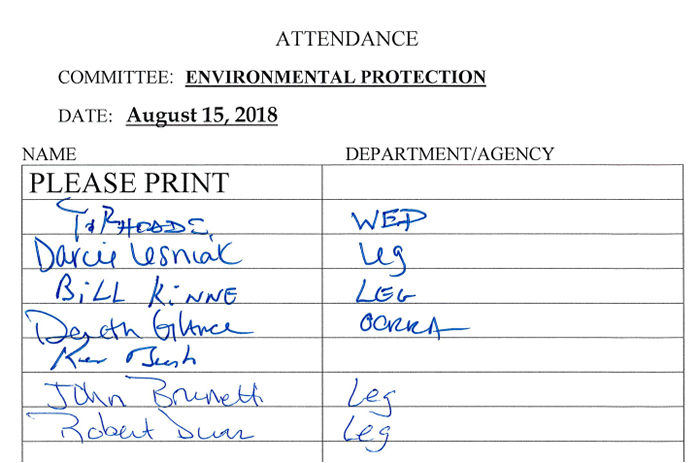
* * *
COUNTY FACILITIES COMMITTEE MINUTES – AUGUST 15, 2018
JUDITH A. TASSONE, CHAIR
MEMBERS PRESENT: Ms. Cody, Mr. Holmquist, Mr. Knapp, Mrs. Ervin
ALSO ATTENDING: Chairman McMahon, Mr. Bush; see attached list
Chair Tassone called the meeting to order at 10:35 a.m. A motion was made by Mrs. Ervin, seconded by Mr. Knapp to waive the reading of the minutes of the previous committee meeting; MOTION CARRIED. A motion was made by Mrs. Ervin, seconded by Mr. Holmquist to approve the minutes of the previous committee meeting; MOTION CARRIED.
1. FACILITIES MANAGEMENT: William Fisher, Deputy County Executive
a. A Local Law Regarding a Lease of Parking Space within the Harrison Street Garage to be used by the County’s Employees
-
Harrison St. Garage - City owns it; Marriot has land lease with City; Triple A parking manages
-
Informally engaged in agreement with Ed Reilly to move some parking for County employees at Hotel Syracuse Garage to Harrison Street Garage; slightly closer; saving $5/month per parking space
-
Concern with Hotel Syracuse Garage, because current owner not putting money into it; less desirable to have people in situation where it is not being properly maintained; continues to be co-compliant with City
-
Tentative agreement with Ed Reilly – 5 year lease on a range of parking between 105-150; working out exact number
-
Confirmed 300 parking spaces unsold every day; feedback from SUNY Upstate that has spaces saying already crowded, etc.; 1,440 spaces and 300 empty
-
Can save money and provide cash flow into garage, so the garage can get elevators and security cameras to the right level; helps everyone
Mr. Fisher replied to Mr. Knapp that the garage spaces are controlled by the hotel, and owned by the City. Mr. Knapp asked if they are typically unused during the day and used at night. Mr. Fisher said Ed (Reilly) told him that the 300 spaces are normally available throughout the day and evening. Mr. Knapp wanted clarification that the County employees will be saving $5 per month, and Mr. Fisher explained that the County pays for them in most cases; collective bargaining agreements to supply parking. Chair Tassone asked if it will be $5 per person, and Mr. Fisher said yes. If it’s 100 people, then it is $500 per month. Mr. Knapp said a lot of the spots are reserved, and asked if some of these are included. Mr. Fisher responded no; these are first come, first serve.
Mrs. Ervin asked if there’s a downside to doing this. Mr. Fisher answered that people in the garage may have to drive higher up in the garage to get a parking space, but there is safety in numbers. Also, full garages generate more money to put money back into it.
A motion was made by Mr. Knapp, seconded by Mrs. Ervin, to approve this item. Passed unanimously; MOTION CARRIED.
2. TRANSPORTATION: Martin Voss, Commissioner
a. Authorizing the Execution of Agreements with the Town of Van Buren Regarding the Shared use of the County’s Department of Transportation Fuel Facility
-
Shared services; good relationship with Van Buren Highway; their garage less than 3 miles from County’s facility in Camillus; which was just built, and has a new fueling station; in process of building new salt shed
-
Enter into agreement with Van Buren, who does not have a fueling facility at their garage; they will buy fuel through County in lieu of building their own fueling station; agreement will allow County to enter into contract with Van Buren
Chair Tassone said this is for all of Van Buren vehicles, and they will each have to put in their code. Mr. Voss agreed, and said everyone puts in a vehicle number, driver number and mileage. It’s a Phoenix system. Each vehicle and driver has their own number. It is tracked electronically, and invoiced monthly. Chair Tassone asked who Van Buren is using now, and Mr. Voss replied the County on an old agreement; this is the new agreement.
Mr. Knapp asked if the County adds a couple cents, and Mr. Voss replied they add $.03 per gallon to cover overhead for having the facility and doing the paperwork. It is a great deal for the County if/when they can secure resources from the state for shared services. It is a great deal for Van Buren, because they do not have to construct a new facility.
A motion was made by Mr. Knapp, seconded by Ms. Cody, to approve this item. Passed unanimously; MOTION CARRIED.
Mr. Voss thanked Brian Donnelly for negotiating the agreement.
b. Amending the 2018 County Budget to Pay in the First Instance 100 Percent of the Federal and State Aid Eligible Costs at a Maximum Amount of $4,230,300 for the Electronics Parkway 2R Paving Project, Pin 3755.71, and Authorizing Execution of Agreements, and Rescinding Resolution No. 57-2018 ($4,230,300)
c. Amending the 2018 County Budget to Pay in the First Instance 100 Percent of the Federal and State Aid Eligible Costs at a Maximum Amount of $1,369,000 for the Construction Phase of the Oran Delphi Road Bridge Over Limestone Creek Project, Pin 3755.22, Authorizing the Execution of Agreements, and Rescinding Resolution No. 81-2017 and Resolution No. 80-2017 ($1,369,000)
-
2 errors to correct; identified by State DOT, while going through contract process, that the County misstated federal reimbursement amounts; state will not process contracts without them corrected
-
Federal fiscal year ends September 30th; needs to be corrected at September session to be on track for next year
-
Current Transportation Improvements Program expiring this fiscal year; need to do directly, get appropriations changed
- Electronics Parkway correct federal amount is $1,095,200; correct state amount is $273,800
Chair Tassone explained that they are rescinding the original resolution and correcting the numbers. Mr. Voss interjected that they are shifting the money around, and there is no new bonding, money or expenses. This is moving things around to make it match what the FHWA and State DOT have in their contracts. The State DOT will not process these without the corrected amounts being on the resolutions. Chair Tassone stated this has to be done by a certain time or else they will lose out. Mr. Voss explained if it goes by the September session, then they will have time to get it to State DOT before the end of their fiscal year. State DOT processes all the FHWA reimbursements. Mr. Voss responded to Chair Tassone that B is for Electronics Parkway, and C is for Oran Delphi Road.
Mr. Voss said Electronics Parkway is a full reconstruction from Old Liverpool Road to Hopkins Road, which is a big project including sidewalks. The home of the Syracuse Nationals is the Holiday Inn in Liverpool, so Mr. Voss said they will work with the contractor that wins the bid to ensure they shut down, and roads are open, during that event. Oran Delphi Road is a bridge project that is a smaller project.
Mrs. Ervin asked that they are only correcting numbers, and Mr. Voss replied that they overstated the federal aid amount, and that is on Transportation. Mr. Voss apologized for the mistake. Everything works out the same, and they are using existing funds to make the changes.
A motion was made by Mr. Knapp, seconded by Mrs. Ervin, to approve this item. Passed unanimously; MOTION CARRIED.
A motion was made by Mr. Knapp, seconded by Ms. Cody, to approve this item. Passed unanimously; MOTION CARRIED.
3. PARKS AND RECREATION: William Fisher, Deputy County Executive
a. INFORMATIONAL: NBT STADIUM – lease agreement; funds available for maintenance, repairs and replacements; bond resolution
- NY Mets acquired franchise, and spent ~$19 mil; still talking with major and minor league baseball affiliation
-
Mets cannot say they are bringing their own players next year; they need approval, which cannot come until Player Development Contract (PDC) with Washington Nationals expires at end of Nationals season
-
Need to wait for Major League Baseball and International League to sign off on it; something like Sept. 16th; then can make it official to bring their own players; cannot announce until approved, and not approved yet
- Mr. Fisher presented the following:
 
- Competitive process; winning vendor – Ewing Cole; above an example of field done in Clearwater; part of spring training facility worked on


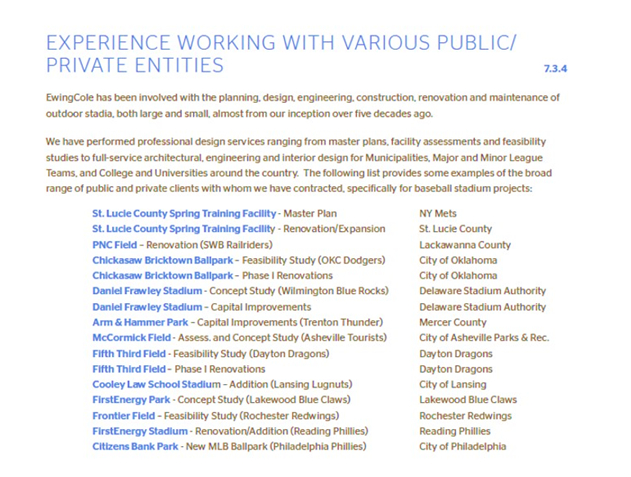
 
 
-
Above left is currently what is there
-
Idea to take outfield concourse and build areas for fans and families to walk, congregate and spend time
-
Upper decks have tarps covering seats; do not need 11,000 seats; pulling people into sections together creates more crowd excitement and a good fan experience
-
Rendering above right – can relocate the club, but probably won’t with expense involved; concept drawing shows they can put something in left field; have areas where kids can play; possibly an entrance
-
Right hand side is entrance not often used; if built outfield concourse, then could be a second entrance heavily trafficked; park in that area, and get into amenities in those outfield areas; can happen well before game starts



-
Mets expressed strong desire to get involved with some sponsorships; current lease says Onondaga County receives 100% of naming rights revenue
-
Mets understandably said if they sell naming rights and maximize revenue, then they want to share the naming rights revenue; if sharing, County would like to know what the Mets will contribute to the cost of the stadium
-
Toronto Blue Jays put in $1 million in 1995/1996; certainly would like to see Mets do better than that
-
If there is revenue the Mets can help generate because their sponsorship sales force does very well, then they can do even better than before; will bring with final lease
- Willing to share revenues if Mets helping sell it, and help build parts of stadium



- Models and variations above; each comes with different cost; schematic shows what can be done
- Meeting few weeks ago with Mets Director of Facilities, Paul Taglieri - look at this and give input on Mets experience
- Conversations on advance stage; narrow down what they are building; need firm pricing; phase 1 complete
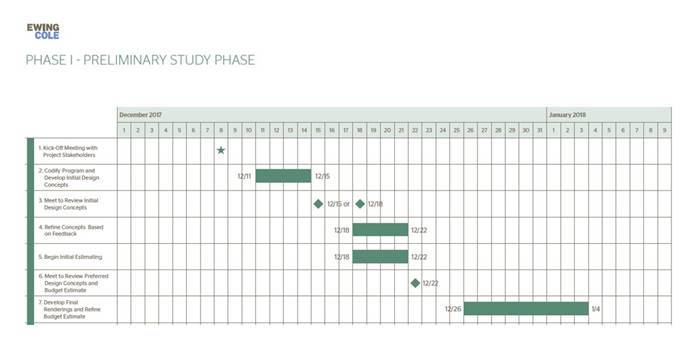

-
Beginning of Phase II included geotechnical investigation; property chosen previously is a challenging site with landfill characteristics; building concourse not as simple as they think
-
Archie Wixson, Facilities Commissioner, worked with one of the term contract architecture firms - 2 studies
-
Studies are public documents, happy to share with committee
-
1 study is data with geotechnical information throughout outfield; other study is considerations report – says if foundation done this way or that way, here’s pros and cons; makes sense for Archie, Mets, and Ewing Cole
-
Not unexpected or most challenging problem, but not easy either; can build concourse out there with reasonable budget
-
Do not have to go as deep in right field as left field; architect working to decide which part of program will go in right field versus left field
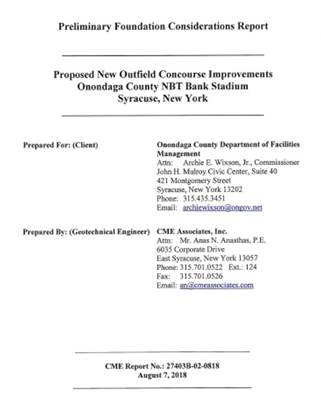
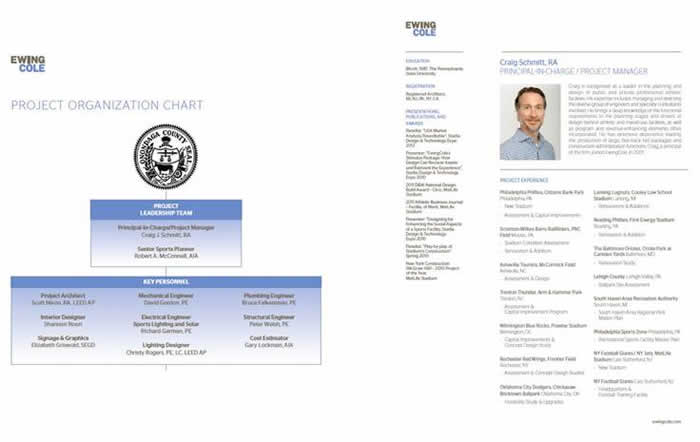
-
Approval from Legislature hopefully at October session; planning to return in September to this committee, if Chair Tassone agrees, and on to Ways and Means with specifics including the lease, cost of project, how it’ll be paid for, Mets contribution, what’s left for the County to do, etc.

-
Could have this firm (that’s remote) have specialty consultants looking at site, and civil engineering, etc., or could use local firms
-
Local keeps money local and they understand the land, etc.; have had good experience working with local vendors and Facilities to build things (i.e. amphitheaters); delivered on time, on budget
-
Focus Ewing Cole on big picture and have them work with local specialty consultants; seems to be right approach


-
Media story coming back saying: the stadium should have been built downtown, why put more money into it, it should be torn down, and built right
-
Response: it’s a fantastic location; just above NBT is Route 81, which carries large number of people every day
-
Over 81 is Thruway; to west is Regional Market – state made investments in; also Regional Transportation Center
-
To West is 370 Parkway; Loop the Lake Trail to take all around the lake (near stadium)
-
DestiNY USA; South of DestiNY is Inner harbor; Onondaga Lake Creekwalk
-
People interested in building projects to west of creek; may come to discuss a project in next couple months
-
Fantastic place for baseball stadium; with additional vehicles, mass transit, people riding bikes, rollerbladers – great opportunity to tie stadium into the lake; is it part of the Park’s system
-
Perfect place to sign lease with NY Mets and bring AAA baseball here for next 20-25 years
-
Invite Legislature to think about what can be done in next 10-25 years to create fantastic center of commerce; economic progress; place where people want to visit and live
-
Anticipate questions; neighborhood not what they want it to be
-
At baseball stadiums, the neighborhood a lot of times is inside the park; walk inside to find (i.e.) Dinosaur BBQ or Empire Brewing; overtime hope to spill over, but do not have to create a whole district if putting amenities inside properties
-
Get fans in on the other side of the parking lot; fans coming in and finding experience; people will show up earlier and stay later as they do with other parks (i.e. Amphitheater); draw people in from further away
Chairman McMahon:
-
Lot of experience with sports and minor league baseball; everything is about fan experience
-
Avid baseball fan does not exist as much as it used to; truly about getting families there for a couple hours spending money, which is how small market teams and communities can have sports teams
-
Short season single A team plays 70 games a year with 35 homes games; AAA affiliated team is 78 home games
-
Communities are building new stadiums, with retail and commercial component; 3 block communities
-
i.e. Augusta, GA, Boise, ID; Las Vegas, NV - developed communities
-
County does not have to do that, because already have DestiNY, Parks system, Inner Harbor; agree well positioned
-
Investment into 25 year old stadium is quite conservative compared to what smaller communities are spending
-
Augusta, GA Single A team – spending over $65 million on facility; Columbia, SC is Single A team – premier facility and amazing how much the public uses it for amenities, and walk through as true park
-
Want to keep franchise at this level; not great fan support in last 10 years; need to make investments to keep it
- Still ironing out what state investments will be; briefed about range - $8 mil or potentially more
Mr. Bush asked if this is a single use facility. Mr. Fisher responded that it was designed as a multipurpose facility. The other purposes tend to be community events the Chiefs put on. The Mets have been encouraged, and said they will be here to do that. Kid baseball games is an option, but there are other things that can be done at a baseball park; especially if it’s easier to get to. Chairman McMahon stated the current lease has community use days that are available, and it became more of a single use venue when it went to grass. Mr. Fisher said there are festivals with music seen downtown that could be brought to the stadium if it’s easy in and out, and has nice amenities and concessions. Mr. Bush asked about high school games, and Mr. Fisher said yes. He explained that the Mets are very eager to do that, and it’s a great outreach. One reason the Syracuse Crunch are successful is because they get kids in to skate after the games, and have their practices there. Mr. Bush said a misconception is that the stadium will be used for 70 days out of the year, and the County is investing millions of dollars into a facility with limited use. Mr. Fisher agreed with Mr. Bush that it is not the case, and that is a point to be emphasized.
Chair Tassone asked if the community days are included in the lease agreement. Mr. Fisher said yes. They moved towards saying the baseball team will do these things, so it is not using taxpayer’s dollars. The baseball team dollars are promoting it.
Mr. Knapp:
Mr. Fisher:
-
Community owned baseball team; small miracle able to keep AAA baseball here as long as they did
-
Shareholders rewarded handsomely ($19 mil); did not invest and make money; looking forward to next quarter century of AAA baseball
-
A team on TV, and on MLB.com - maybe Tim Tebow next year; players that get hurt and come back for rehab assignment; seeing same people as those on TV
Chairman McMahon said the Mets will not send their real players on assignment to Las Vegas, because it costs more money; right now they go to Binghamton. The County will get Tier 1 talent, and the Mets own the ticket sales. There will be a financial incentive for good players.
Mr. Knapp asked who would schedule things like a high school tournament. It would need to be coordinated with the Mets, and Mr. Knapp asked if it is County Parks. Mr. Fisher answered that the County has the right to use the park, but they have not used it. Currently the Chiefs have been good about doing it themselves, but Mr. Fisher said they can make sure the new lease has that recourse if needed. The more the community is involved, the better it is for the business.
Mr. Fisher said they want people to think about how to get the neighborhood developed. Mr. Glazier explained:
-
Brownfield Opportunity Area (BOA) – Hiawatha Boulevard to Lodi Street; BOA has been around since 2008; have groupings of Brownfield sights that offer additional incentives
-
Changes to BOA since 2015; in 2019 - if in BOA zone, which is Baseball Stadium and Hiawatha Boulevard corridor (primary area), then a person can apply for CFA to get a grant for improvement within that corridor
-
If in Brownfield Cleanup Program (BCP) within a BOA, there is up to 24% tax credits
-
i.e. Private developer investing in remediation of Brownfield sight can get back up to 24% of investment
-
Lucrative properties; BOA’s in place, but properties have not turned around as hoped; combination of 3 programs all within BOA zones: environmental zones, BOA and BCP
-
Good property owner understands benefits, then they will have incentive for redeveloping properties
-
Opportunities are getting better; community can consider who should be looking at CFA process under this specific pot of money to see improvements in that corridor
Mr. Fisher:
-
2 villages somewhat connected, but could be better connected: Liverpool to east of lake, and Solvay to the west
-
How the suburbs going; could go in direction of City or more positive direction; both on the fence
-
If they can connect commerce here (stadium) to 7th North hotels, it’ll be huge; connect commerce happening here with things at Fair Grounds; i.e. Syracuse Nationals – Fairgrounds and Town of Salina
-
Want more of the development that takes advantage of unique destination marketing opportunities; travel and tourism opportunities that spill into villages nearby; they need help; Solvay – amazing what Community Development has done
-
If the County focuses on something, and gets state interested, then can do something; those that’ll still be here should focus on this for next 25 or 30 years with AAA guaranteed by NY Mets
Mrs. Ervin asked what changes are being made. Mr. Fisher responded:
-
Take main entrance and make friendlier to those with mobility challenges
-
Take entrance in right field rarely used, and make simple to come in
-
Whole ball park based on climbing stairs; outfield is not built up, but built along ground; do not want to make people climb stairs through concourse to get to right field
-
How do they get people into park without big expense to club with 2 different gates?
-
Will look at ADA parking there; how to shuttle people – try to apply what they learned at Lakeview Park to this
Mrs. Ervin stated her last experience at the ballpark was awful with her brother-in-law in a wheelchair. They were sent up in the elevator, but they were going to the party plaza that was down. Mrs. Ervin said her brother-in-law could still walk, but was nervous about coming down, so his aide had to carry him down the steps to get to the party place. No one tells you how to do anything, and it definitely needs to change. Mr. Fisher said he will make sure Ewing Cole, and the specialty folks working with them, makes this a top priority.
Mr. Holmquist said it was a nice overview, and with what the team has had, they’ve done a great job. There have been lots of upgrades to the vendors. The overall concept is very good, and there are great opportunities on all points made. Mr. Holmquist said one goal is a loop to walk all the way around the outfield, and Mr. Fisher said yes. Mr. Holmquist wanted clarification that they have not yet settled on a plan, but there were several plans. Mr. Fisher replied yes. It is a mandatory feature to be able to get all the way around, whether at ground level or terrace level. To see the game, people would want to be above the fence. Mr. Fisher explained that they may change the dimensions of fence to be a more interesting contour. Mr. Holmquist asked if all the plans included replacing all the seats, and Mr. Fisher responded no. Mr. Fisher believes they will replace the seats in the lower bowls with the wider seats, and leave the ones on top alone (because of the expense). They are looking at a terrace or suite experience up there that people will not have to pay for. The stadium is old, and some feel it is in the wrong place, but there’s a pony in there somewhere. If they can create an experience at a reasonable cost, then they can get that pony looking really good.
Mr. Holmquist asked what the Legislature’s role is, and said Mr. Fisher indicated there might be a proposal at budget. Mr. Fisher responded:
-
Would like to bring something over at the end of September
-
State, when they originally helped fund, put up cash; County borrowed some money; Chiefs prepaid some rent - County borrowed against naming rights; putting together package along those lines
-
State wants to see matches; currently working out what is the percentage; might be 50/50 match
-
Ed Kochain said the state last time allowed in-kind work done by DOT and Drainage and Sanitation
-
That would be credited against state money; make sure state money goes as long as possible
-
Might ask Legislature to use DOT money, WEP money, or naming rights money to be part of match and maximize grant
-
Done in 1995 – had Law look into what was done
-
Project will be public work, so will have to be bid and follow procurement laws
-
Some work will be done before next season, but not outfield work; possibly the seats; some things done during the season, and will finish after next season; by opening day 2020 it’s done
Mr. Holmquist stated that process matters. It’s in everyone’s best interest that the Legislature is fully included and updated, and given the time to fully vet it. Mr. Fisher responded:
-
Would like to come back in September to Facilities committee; assuming Major League Baseball and International League approve change for the Mets to bring their own players
-
Being told that could be announced around September 16th; Ways and Means would happen after that
- Would love to say Mets will be here after they announce it; would be dependent on Legislature
Chairman McMahon:
-
One thing that changed from his involvement to now is state put number in budget; now state’s position changed to say they put in 50%, and the Mets put in 50%
-
Difficult because Mets already put up $19 million to buy the baseball team; not interested in putting in numbers like that
-
County thought project would be here, state would get money budgeted, then have well rounded project
-
State re-positioned, so maybe the state can go back to what they originally thought; this would allow County to do more with the project
-
Numbers - $8 million bond plus whatever the County can get with naming rights
-
Belief that NY Mets buying power is better; if County can get $250 - $300,000 per year, then more back into the project
- Those are the numbers used on the local side
Mr. Fisher:
-
Bond resolution, and separate resolution; accepting future naming rights revenue
-
Originally Legislature approved agreement of $3.75 mil for P&C; payment in 2022 will get the County to $3.75 mil; October 1st, 2024 (last season of current lease) will get the County a little more
- Project will then be fully satisfied; can pledge naming rights, and Mets saying they will be there
A motion was made by Mr. Knapp, seconded by Mrs. Ervin, to adjourn the meeting. Passed unanimously; MOTION CARRIED.
The meeting was adjourned at 11:38 a.m.
Respectfully submitted,

JAMIE McNAMARA, Assistant Clerk
Onondaga County Legislature
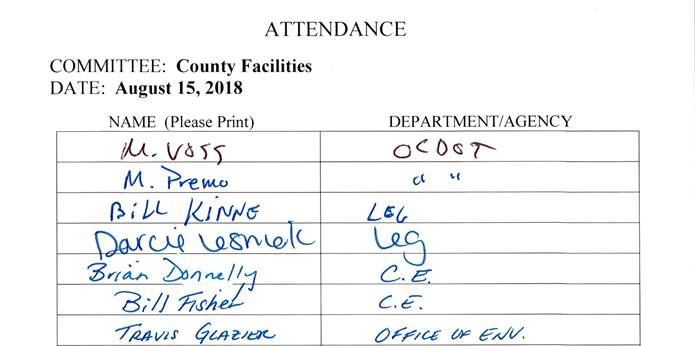
* * *
PUBLIC SAFETY COMMITTEE MINUTES – AUGUST 15, 2018
CHRISTOPHER J. RYAN, CHAIRMAN
MEMBERS PRESENT: Mr. Bush, Mr. McBride, Mr. Rowley, Mr. Jordan
ALSO ATTENDING: Mrs. Ervin; see attached list
Chairman Ryan called the meeting to order at 12:04 p.m. A motion was made by Mr. Jordan, seconded by Mr. Rowley, to waive the reading of the proceedings from the previous committee. MOTION CARRIED. A motion was made by Mr. Jordan, seconded by Mr. Rowley, to approve the minutes of the previous committee. MOTION CARRIED.
1. EMERGENCY COMMUNICATIONS & EMERGENCY MANAGEMENT: Ann Rooney, Deputy County Executive/Human Services
a. INFORMATIONAL: Emergency Services
Ms. Rooney:
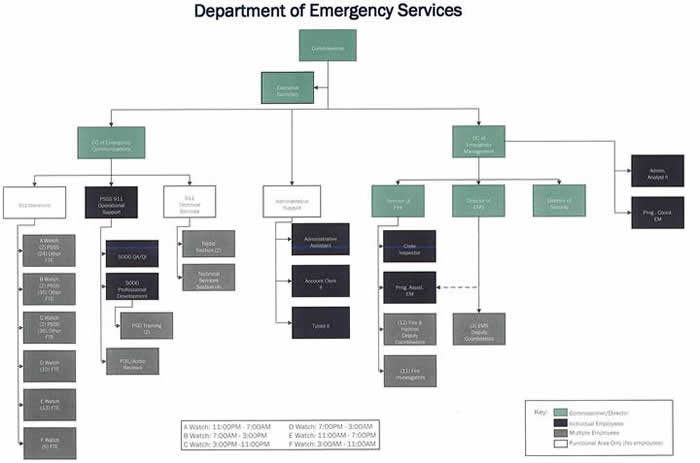
-
With last year’s budget we proposed consolidating the Department of Emergency Management and Emergency Communications (911) into the Department of Emergency Services, the legislature asked that it be brought back this year with an informational allowing time for contemplation before the budget process
-
Made a few tweaks to last year’s proposal, worked closely with the department commissioners; change stems from the fact that Emergency Communications is a component of everything in Emergency Management, for best practice many places across the county combine these functions into one department, much of what is done at 911 is driven by information received from the directors of fire and EMS, makes sense for management decisions to be made together, i.e. strong recommendation from the School Safety Taskforce that 911 be included in all planning; want to be in a position where 911 is always aligned and working with public safety, fire, and EMS at all times
-
Consensus favors this – if we ask other to look at how they do business, we must do the same
-
Creates commissioner for the department, no additional appointed positions, abolishes the commissioner of 911 and Emergency Management positions, creates deputy commissioner positions for 911 and Emergency Management; synergy created from management team working together is the biggest thing
Chairman Ryan asked the budget ramifications. Ms. Rooney said that the grade needs to be the same for both deputy commissioners. The dollar amount would be under $10,000 if there is any budget implication at all. In answer to Mr. Jordan, Ms. Rooney confirmed that they are not looking for any reduction in staffing. Currently, Emergency Management has almost no administrative help and this would allow them some capacity. Also, grant expertise and contract administration, on the Emergency Management side, would be spread across the larger department to look for grants on the whole spectrum; a definite advantage. Chairman Ryan said that everyone would be under one umbrella where they could participate in clerical duties, grant writing, and grant applications. Ms. Rooney agreed, reiterating that there is currently no clerical staff on the Emergency Management side and no grant staff on the 911 side. Bringing them together provides efficiencies to serve the larger department.
Mr. Bush asked where they would be physically located. Ms. Rooney responded that currently 911 is on Onondaga Hill and Emergency Management is in the subbasement, which also serves as the backup location for 911. Mr. Bush asked if they would be housed in one facility. Ms. Rooney responded that they will not be located together off the bat. Similar to many other departments, the management team and structure working together is what we are trying to accomplish; will look at the possibility of co-locating down the road.
Mr. Bush questioned the flow chart for similar counties. Ms. Rooney responded that Broome County is the closest county in NY, which has done a lot to bring functions together. Monroe County has done an unbelievable job of bringing many public safety functions under one roof; really impressive, wonderful for training and working together, Sheriff, Emergency Management, Fire, and 911 all under one roof. That is the best practice, right now our geography doesn’t work but it is something we would like to explore in the future. A few years ago Erie County had a bad snowstorm and coordination was very difficult because they have 20 separate 911 centers.
Mr. Rowley asked if these departments were primarily funded by local dollars, aside from grants. Ms. Rooney responded that the Emergency Management side is roughly 50%, 911 personnel is largely local dollars but we get a lot of grant funding for technical improvements. In answer to Mr. Rowley, Ms. Rooney confirmed they do not expect this to affect state aid.
Chairman Ryan said Ms. Rooney mentioned that multiple 911 centers caused confusion and asked if everyone would be co-located down the road. Ms. Rooney responded that is certainly a goal and we are in discussion with Madison County; state money will fund a study to look at merging Madison County 911 into Onondaga. Smaller counties will not be able to keep up with the rapid technological advances and there are advantages for larger counties. We will have to take a serious look at where we are located if our purpose is to become more regional with 911.
Ms. Rooney stated the information is being provided now so that it will be fresh in everyone’s mind. Chairman Ryan asked if there were any further questions. Mr. Rowley responded that he will wait to see the budget. Chairman Ryan thanked Ms. Rooney.
Chairman Ryan said that Leader Ervin and he discussed having a joint meeting with the Health, Human Services and County Facilities committee to discuss the potential ramifications of Raise the Age - how we will accommodate additional people at Hillbrook and how those implications will spill over into Human Services. This topic was discussed at length during the recent Criminal Justice Advisory Board meeting which contained members of the DA’s office, judiciary, probation, police chiefs and everything else. There is a lot of discussion and tentacles. The whole issue of Raise the Age transcends into numerous committees and we would like to hold the meeting at Hillbrook. Ms. Rooney suggested having the meeting as one of the committee meetings next month. Chairman Ryan stated that Sheriff Conway will also be providing an update to the committee next month, and he is willing to hold the Public Safety Committee meeting at Hillbrook if it works for everyone. Mr. Jordan said that the only potential complication may be dovetailing this with the budget process. Mrs. Ervin said that the committee meeting is the week before. Mr. Jordan said that he was just raising it as a consideration. Chairman Ryan said he would start working on the joint meeting today.
The meeting adjourned at 12:20 p.m.
Respectfully submitted,

KATHERINE M. FRENCH, Deputy Clerk
Onondaga County Legislature
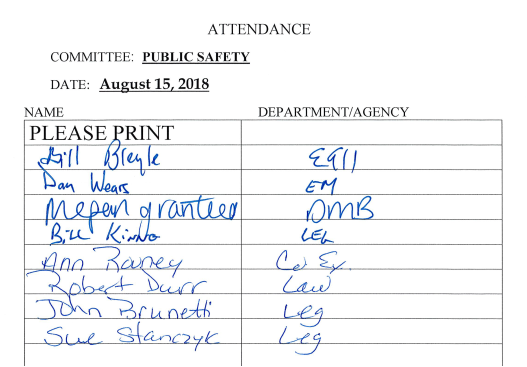
* * *
HEALTH COMMITTEE MINUTES - AUGUST 16, 2018
TIMOTHY T. BURTIS, CHAIRMAN
MEMBERS PRESENT: Mr. Rowley, Ms. Cody, Dr. Chase, Ms. Williams
ALSO ATTENDING: Mr. Bush; see attached list
Chairman Burtis called the meeting to order at 9:31 a.m. A motion was made by Mr. Rowley, seconded by Dr. Chase, to waive the reading of the proceedings from the previous committee minutes. MOTION CARRIED. A motion was made by Dr. Chase, seconded by Ms. Cody, to approve the minutes of the proceedings of the previous committee. MOTION CARRIED.
1. HEALTH: Dr. Indu Gupta, Commissioner
a. Authorizing a Lease Agreement with Alexander Properties West Limited Liability Company for the use of such Property in Connection with the Onondaga County Women, Infant and Children (WIC) Program
-
New location for WIC - includes administration and clinical services; currently at 375 West Onondaga Street
-
Pregnancy and early childhood are most important times in development
-
WIC started in 1972; at W. Onondaga for over 25 years; 2016 building sold, and lease not being renewed
-
Have to follow NYS Department of Health guidelines, because 100% grant funded; make sure it fits needs of community, in geographic area where participants are to be able to come, accessible to eligible population
-
Proposed site is 307 Gifford Street, Syracuse; 7,000 sq. ft.; close to key patterns in community including: St. Joe’s Primary Care West Center – babies and pregnant women able to get care
-
Nearby: CVS Pharmacy, bus stop, I81 and 690
-
Ground floor access - pregnant women, some with strollers and multiple kids; more appealing, inviting and warm environment; important for women going through vulnerable time
-
When going to doctor’s office, want to feel like they care and to feel welcome; then they will continue to come
-
45 parking spaces, 100 available; alarm security on all doors – keep people’s information protected
-
100% grant funded; budget $10,161.67; total monthly rent and landlord costs $121,940
Dr. Chase asked if they are doing renovations, because it was a grocery store (very open). Dr. Gupta replied:
- Things have changed over last several years with NYS guidelines; how the clinic should be client friendly
- Time gets wasted, so increase efficiency; how to have client in one room, and staff one by one
- Working with state to ensure this fulfills new requirements - see more clients efficiently; open space provides that
Ms. Williams commented that the current location is congested, so this is a great thing. There is no privacy when talking to the Mom. Dr. Gupta said in the last several years in the community things have changed. It is important where a person gets care, and that it is a connective corridor where things can get started.
Mr. Rowley asked if the County will use the entire 7,000 sq. ft., and Dr. Gupta responded yes. This is what they have in the other building, so they stayed with the same requirement. The range is 75 – 100 clients per day, and the max is 175 people for foot traffic. There is a no show rate, but they have to be prepared. There are also different places for nutrition testing, education, breast feeding, etc. that will require this space. Mr. Rowley asked how much staff will be there. Dr. Gupta replied the total is 8 – 10 staff that rotate in two different locations.
Mr. Bush said Dr. Gupta talked about this being funded (assuming federal and state), and asked if there are any County funds involved. Dr. Gupta answered that it is 100% state funded. Mr. Bush asked if they will renovate the interior of the building with state and federal funds. Dr. Gupta replied that everything is included in the lease. Mr. Bush said it is well over $100,000 per year, which is going to be funded by federal and state. Dr. Gupta restated that there are no County dollars here. Mr. Bush said the building is wide open, and asked if all the furniture and set up for offices will be fully funded. Dr. Gupta explained that they have a lot of furniture already, and will make sure they reuse what they have. Anything additional that needs to be done is part of the lease, which is covered by state funding. Mr. Bush said it’s a great deal. Dr. Gupta commented that the funding goes from federal to state to the County.
Mr. Bush asked where the Camillus site is, and Dr. Gupta replied St. Michaels. The West Onondaga site is the main site with extended hours, and administration is located there. Mr. Bush said there are only two sites in the City including this and Assumption. Mr. Bush stated he was around when WIC started, and they were a lot more into the community versus now being more centrally located. Having the other sites made it easier for those that do not drive. Dr. Gupta responded that because of the secure information, they need secure servers. Currently they are exploring the idea of doing some ad hoc places, but all staff has to be there. Dr. Gupta said she is open to any suggestions.
Mr. Bush asked about technology and registering at home. Dr. Gupta explained:
-
It’s not about getting a check, but having human connection; working with partners to promote the program to community members, including those working with transportation
-
Not only program Health Dept. has; (i.e.) Healthy Families for home visiting; the programs have community outreach, they meet with organization leadership and community leadership, then take information to make connections
-
Transportation important - bus hub nearby
-
Working with multiple CBO’s who are part of advisory of Healthy Families to promote services
-
Working with Dept. of Social Services – lot of same clients; how do they connect; conversations to serve community
Chairman Burtis stated this is an excellent opportunity for WIC. Everything is included in the resolution and the lease. The lease annual rent rate includes utilities, taxes, property insurance, snow plowing, landscaping, garbage removal, and infrastructure improvements. This is a five year term with the possibility of two renewable periods of five years each. There is transportation, space to grow, and they can do everything they need to do.
A motion was made by Ms. Williams, seconded by Dr. Chase, to approve this item. Passed unanimously; MOTION CARRIED.
b. Transfer from Health, Account 666500 Contingent Account, to Health, Account 694080 Professional Services, $41,000
-
Continue to monitor mosquitos and bugs; notified last week that 1 mosquito pool tested positive for Eastern Equine Encephalitis (EEE), which means mosquitoes are infected with virus; deadlier than West Nile
-
Check mosquito numbers and time of year; should they consider doing additional public health measures (i.e. spraying) in addition to spreading the protection measures
-
Talked with state, and decided to do spraying (weather dependent); will be getting Imminent Threat Declaration
-
County’s decision if they feel the community is in jeopardy or at risk, then can go forward with spraying
-
Mosquito numbers down, but are going up; having mosquitos with this infection will breed more with the infection
-
People not taking precautions, then can get infected; 20% of people can have negative consequences
-
Asked for area spraying; weather dependent: cannot do in rain; have to watch wind velocity
-
Asking for funds from contingency in amount of $41,000
Chairman Burtis commented:
- District 3 - Cicero Swamp and Bridgeport areas; last year the County did not spray
- Dr. Gupta’s background is “do no harm”, versus the residents around Cicero Swamp who want the mosquitos dead
- Idea is that the County is not here to kill mosquitos; there has to be a health related reason to spray pesticides to kill
- Why would the County wait so long? Again, they have to have a health related reason; also it has to be at height of mosquito season
- When the County finds these negative health related reasons, then they will take action; make sure residents understand
- Not totally sure when spraying, but imminent and weather related
- County has contract with Duflo Spray Chemical (based in NYS) who has sprayed swamp before
Ms. Cody asked if the swamp is the only area they found EEE, and Dr. Gupta answered yes. Dr. Gupta said:
- East Taft Road (tested positive twice) and Route 298
- State very strict about how the County goes about this; protecting the environment is very important
- Idea is do no harm to existing population; if they overkill, there are consequences; a hard decision
- Last year EEE tested positive, but it was at the end of the season; no point in doing anything at that time
- County does not do kneejerk reactions; look at time frame along with the pros and cons
Chairman Burtis said there is a way to do this, and a time to do this. The best timing is when there is a maximum number of mosquitos in the air, so when they are sprayed, there is a maximized kill. That is where wind and time of day play a part. The County is using reverse 911 calls, media, and social media to get the word out, so folks will be prepared; especially in that area.
Dr. Gupta added that people still have to protect themselves even with spraying, and they should not be complacent. When people are outdoors, they should be using insect repellent.
A motion was made by Dr. Chase, seconded by Ms. Williams, to approve this item. Passed unanimously; MOTION CARRIED.
Chairman Burtis expressed his discontent with the Governor’s comments from the previous night. Chairman Burtis believes that America is a great nation, regardless of the Governor’s political ambition, or his political views. He does not believe it is honorable for the Governor, or any elected (state or federal), to say something like this. It was a mistake, and he thinks the Governor should apologize. Chairman Burtis thanked the committee for giving him liberty on this. Ms. Williams commented that she has been thinking about what the President of the United States has said and done as well.
A motion was made by Mr. Rowley, seconded by Ms. Cody, to adjourn the meeting. Passed unanimously; MOTION CARRIED.
The meeting adjourned at 9:55 a.m.
Respectfully submitted,

JAMIE M. McNAMARA, Assistant Clerk
Onondaga County Legislature
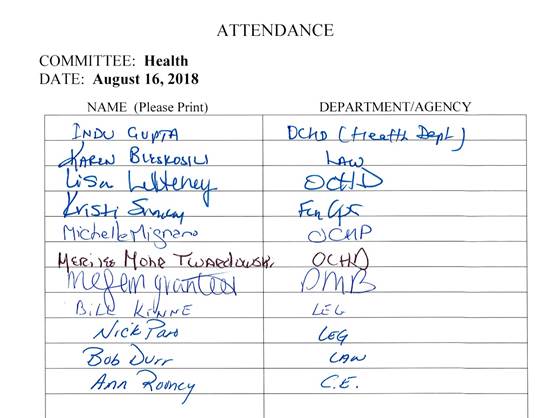
* * *
PLANNING & ECONOMIC DEVELOPMENT COMMITTEE MINUTES - AUGUST 16, 2018
JOHN D. McBRIDE, CHAIRMAN
MEMBERS PRESENT: Mr. Holmquist, Mr. Burtis, Mr. Plochocki, Mr. Buckel
ALSO ATTENDING: Mr. Knapp, Mr. Bush; see attached list
Chairman McBride called the meeting to order at 10:32 a.m. A motion was made by Mr. Burtis, seconded by Mr. Plochocki, to waive the reading of the proceedings of the previous committee. MOTION CARRIED. A motion was made by Mr. Buckel, seconded by Mr. Burtis, to approve the minutes from the previous committee. MOTION CARRIED.
1. SYRACUSE/ONONDAGA COUNTY PLANNING AGENCY:
a. Confirming Appointment and Reappointment to the Syracuse/Onondaga County Planning Board (David A. Skeval, James Corbett)
Chairman McBride said that Mr. Skeval has an impressive resume. He is the executive director of Cornell Cooperative Extension and has numerous achievements. Mr. Plochocki stated he had the pleasure of serving on the Cornell Cooperative Extension Board and Mr. Skeval has done a great job. Mr. Burtis echoed the same.
A motion was made by Mr. Plochocki, seconded by Mr. Burtis, to approve Mr. Skeval. Passed unanimously; MOTION CARRIED.
Chairman McBride said that Mr. Corbett is well known by all both personally and professionally. Mr. Burtis stated he had the opportunity to be on the NYS Region 7 Fish and Wildlife Management Board with Mr. Corbett, who is a great outdoorsman, and he does a great job on the Planning Board. Mr. Plochocki stated he also served on the same board with Mr. Corbett and he is excellent. Chairman McBride stated he has known Mr. Corbett for 27 years and echoes all their comments, adding that he is a good quality person.
A motion was made by Mr. Plochocki, seconded by Mr. Burtis, to approve Mr. Corbett. Passed unanimously; MOTION CARRIED.
b. Confirming the Appointment of Daniel Kwasnowski as the Director of Planning for the Syracuse-Onondaga County Planning Agency: Mary Beth Primo, Deputy County Executive/Physical Services
Ms. Primo:
- Introduced Mr. Kwasnowski as the County Executive and Mayor’s joint appointment to Director of SOCPA
-
Position has been vacant for close to 3 years, over 2 years ago during Mayor Miner’s administration much effort was put into finding a director, advertised position and received a lot of interest, held a couple of rounds of interviews, to the County team Mr. Kwasnowski was the strongest candidate, for various reason the Mayor and County Executive could not come to agreement on a joint appoint; thanked Mr. Jordan and Ms. Costa for doing a wonderful job leading SOCPA during this period; enjoyed working with them, both are real professionals
-
Mayor Walsh was elected in January, one priority of the County Executive was to jointly appoint someone to this position, both consider various people but could not come to an agreement, 6-8 weeks ago decided to see if Mr. Kwasnowski was still interested, he met with the mayor and deputy mayor who were equally impressed, soon after the joint appointment was sent to the legislature; strong candidate, many legislators met with, know, or reviewed his resume, he is a strong communicator with a wealth of municipal experience: Town of Dryden Planning Director for 8 years, served on the Village of Marcellus Planning Board while Mr. Plochocki was Mayor and has a consulting business; urged support of this appointment
Mr. Kwasnowski:
-
Thanked Ms. Primo; has been interested in this position for some time, has never done consulting work in Onondaga County which puts him in a good position, knows a lot of people but has no favoritism or ties
-
Being a planner is a daunting job, he accepts the challenge, looks forward to working with everyone, and will use his experience to help solve current problems
-
Really important to keep an eye on the future, create a vision for what we want that future to be where all find common ground, and find a way to achieve it, this is what planning is really about, need to incorporate people
-
Planning ethos - community-based planner 1st, design-based planner 2nd, combine the two whenever possible, not always easy to do because of budgets, community level must come first, can’t build consensus and form a common vision without incorporating as many people as possible; his policy background is in a democratic community-based participatory process
-
Don’t use a lot of planning jargon, unless needed for a specific solution, try to talk about things that will resonate with people and communicate at their level, worked with farmland protection and urban and rural zoning, can speak all those languages, terms used will depend on whom he is talking to; mostly try to listen and learn something from any conversation
Mr. Buckel stated that he has stressed strong views on economic development and different philosophies in the past. He remains concerned over the general economic malaise of our region. Economic growth is always best served by enterprises that are local, and created locally, as opposed to the philosophy of trying to recruit from the world something that thousands of communities are trying to do. Perhaps more than the last generation, there are some incentives on use of the federal tax bill to create enterprise on local levels. He then asked Mr. Kwasnowski for his thoughts on how we would use this to create local enterprises that start with 1 to 10 people, and how we segment it into groups that have different demands and challenges. There is a whole range of groups that fit into different categories and he would like to know some of the thoughts Mr. Kwasnowski is bringing into this role. Mr. Kwasnowski responded:
-
While being a consultant he had an opportunity to use a vacant storefront to open a bike shop, very familiar with opening your own local business, realized it was a lot of work and being a consultant paid much better; the building was sold and converted into apartments and a diner, now a thriving building; his wife owns a business and struggles with the opposite curse of success, how much do you grow, how fast, how many people are needed at any given time, etc.; often talk about owning your own business, finance and what it means
-
The high-level tax incentive moves down and we need people to take advantage of it through local grant giving, people supporting nonprofits or whatever it is; the long-range plan for economic development should be to create a place where people want to live and locate their business and then they probably will; the current business climate, especially at the regional level, is super hard with everything online, very difficult to find your niche and start a retail business, need to have your ear to the ground in our downtowns and local villages
-
Economic security is a large part of sparking someone’s entrepreneurial spirit to go out on a limb and start a business; we must do a cross-section of our population to determine what age groups are likely to start a business, what they need and what can we do to help
-
Not everything can be solved at the government level, private capitalism has to come from somebodies mind and spirit, it is tough to start and maintain a business; most determine how to diversify land use so that mixed-use buildings can support the overhead of the business, i.e. own storefront with apartments above saving the cost of rent
Mr. Buckel stated that he criticizes many things in the new tax bill, however, the one thing it does is shift the incentive from jobs and wages to ownership and business creation. Knowing this is available on the national level if he forms a business he has different skills and can access capital and ideas in a way that other parts of our community cannot. His pushback to Mr. Kwasnowski is to be aware of the different challenges of our community and the explosive growth potential with any kind of enterprise ownership can bring. Challenges are different depending on the status of different people, groups, regions, and even where one lives within our community. Mr. Kwasnowski responded that maintaining a place where people want to live is an important element. People will locate their business where they want to be. We have natural resources here with water and agriculture but he questioned if we have the people. He agrees that this will incentivize people to start businesses, we just have to make sure we are on their list of places they want to be. Mr. Buckle stated that workforce development is also part of it and Mr. Kwasnowski agreed.
- Has been watching Duluth, MN because they are a similar size, uses NORTHFORCE – an interesting economic development program for career connection, reaches out to other markets and lets them know they have jobs and land for development, also considers quality of life aspect; actively buys marginal land to improve the quality of life in their community, neat program, check it out if you have the opportunity
Mr. Plochocki stated that while mayor of Marcellus, he met Mr. Kwasnowski after a public meeting and was immediately impressed by him as someone with skills and interested in community things. Mr. Kwasnowski agreed to join the village planning committee and became the chairman in a short time. Personally and professionally he is a great guy and has done a great job.
Mr. Holmquist stated that it was nice to meet Mr. Kwasnowski in person; had a nice phone conversation and he is looking forward to working together. Mr. Kwasnowski comes highly recommended from all corners of the community, has an outstanding resume, and is well suited for this job. Mr. Holmquist stated he is excited about the future.
Mr. Knapp echoed Ms. Primo’s early comments referring to Mr. Jordan and Ms. Costa. They have done an absolutely tremendous job. Mr. Jordan threw himself into working with the Ag Council and most importantly helped to save the towns thousands and thousands of dollars on the GIS side; provided maps and other items that towns would normally have to pay for or bring in their own staff to create.
Mr. Knapp asked where Mr. Kwasnowski sees the County’s role in working with towns on what they’d like to do with their planning functions and what the County is doing. Mr. Kwasnowski responded that this was a great question. Except for City Zoning, we don’t have that land use component. Helping communities to stay focused on thinking about the future is where we can really lead. One of the most dangerous things a board can do is to spend too much time reacting and not enough time proactively thinking about the future. Mr. Jordan and Ms. Costa have done a great job and you could muddle along for a long time like that. The reason for his role is to have someone out talking to the community and thinking about the future, which is not an easy thing to do. It is something that has to be facilitated and people have to get used to. Plans need strategy and synthesis in order to come together as a whole. Considering how each town and the city plan can come together to form one vision is the real value. Problem-solving is super important on a day to day basis, but building consensus towards that future vision, and then tying each postage stamp together into one quilt is what he finds rewarding; working together to make each stronger instead of competing with each other. He is speaking vaguely as he does not know what those things will be yet and it must be done continuously. He would like to do the hard work of forming a framework so that local communities know they can go to SOCPA and ask for help. If we can get that far, or even halfway, we can then get the resources to actually make that happen; good vision with community support is more likely to bring resources in. Mr. Knapp said that he sees this as a perfect opportunity for Mr. Kwasnowski to go on a listening tour around the various towns and villages, introduce himself, and hear what they are thinking. As technology has changed there is a lot of opportunity for synergies; less us versus them and more working together. This is a great opportunity to reintroduce the SOCPA organization and what their assets and liabilities are. Mr. Kwasnowski agreed.
Mr. Buckel said that he will hear that all think their community happens to be the best place to live. It sounds like Mr. Kwasnowski has a great grasp on the kinds of coordination and listening needed to build consensus. All can agree we live in a great place, with a few hiccups, but we also want to live in the best place to do business, which is really the challenge of our time. Mr. Kwasnowski agreed.
Deputy Mayor Owens said that from the city’s perspective Mr. Kwasnowski’s credentials are clear. The challenge is taking that skill set and actually making it applicable to use. We had a long conversation about how to apply the customer service process to our zoning, planning, and personnel working in the Planning Department. The best-laid plans mean nothing if it doesn’t translate into a usable pattern for business and our residents. We were very pleased with our conversation and are looking forward to having Mr. Kwasnowski.
-
Thanked Deputy Mayor Owens; worked in a lot of positions not listed on his resume, i.e. grocery store assistant manager, brought that spirit and knowledge to the Dryden Planning Department and provided a service attitude that people complimented as the greatest office to work with, wanted them to build things and succeed
-
Also talked a lot about the transparency of process, the zoning office is the customer service shop, cross-trained all staff so that even when busy someone could be attended to, that type of retail service process is inherent to him and he will work to get it implemented
Mr. Buckel stated to keep it simple and responsive. Mr. Kwasnowski responded that the new code should help with that, though he has not seen it. If it is as reported it should be less intent on uses and more intent on building things.
Chairman McBride stated he also had a great phone conversation with Mr. Kwasnowski. It was very productive and impressive, and he thinks everyone learned today that we have the right person, for the right job, at the right time.
Chairman McBride thanked Mr. Kwasnowski and Ms. Primo for taking the time to speak to the committee.
A motion was made by Mr. Buckel, seconded by Mr. Plochocki, to approve this item. Passed unanimously; MOTION CARRIED.
Mr. Bush echoed Mr. Knapp’s comments stating that as a former town supervisor the Planning Department has been outstanding in supporting the towns.
Mr. Bush said that he did not understand why the Mayor had to agree to a County position. Mr. Plochocki responded that several years ago the County and City Planning Departments were combined into one. It is the only department that we can truly say is joint government between the County and City. Part of the deal when combining this was that it would be a County department on paper, with county employees and the City making contributions. With that being said, the Mayor would have to agree to the appointment. Mr. Knapp added that the City also pays for half of the salary and reimburses the County for city planning and zoning positions. It is truly a combined Syracuse Onondaga County Planning Agency.
A motion was made by Mr. Burtis, seconded by Mr. Buckel, to adjourn the meeting. Passed unanimously; MOTION CARRIED.
The meeting was adjourned at 11:10 a.m.
Respectfully submitted,

KATHERINE M. FRENCH, Deputy Clerk
Onondaga County Legislature

* * *
WAYS AND MEANS COMMITTEE MINUTES
August 27, 2018
BRIAN MAY, CHAIRMAN
MEMBERS PRESENT: Mr. Jordan, Mr. Ryan, Mrs. Ervin, Mr. Plochocki, Mr. Knapp
MEMBERS ABSENT: Ms. Williams
ALSO PRESENT: Chairman McMahon, Mr. Bush, Dr. Chase, Mr. Rowley, see also attached list
Chairman May called the meeting to order at 9:12 a.m. A motion was made by Mr. Knapp, seconded by Mr. Jordan, to waive the reading of the minutes of the proceedings of the previous committee. MOTION CARRIED. A motion was made by Mrs. Ervin, seconded by Mr. Jordan, to approve the minutes of the proceedings of the previous committee. MOTION CARRIED.
Chairman May took the agenda out of order.
2. LEGISLATURE:
a. Calling for a Public Hearing on the 2019 County Budget
- October 6, 2018 at 6:00 p.m.
A motion was made by Mr. Jordan, seconded by Mr. Knapp, to approve this item. Passed unanimously; MOTION CARRIED.
3. HEALTH: Dr. Gupta, Commissioner
a. Authorizing a Lease Agreement with Alexander Properties West Limited Liability Company for the use of such Property in Connection with the Onondaga County Women, Infant and Children (WIC) Program
- Location for 25 year WIC program; NYS Dept of Health requirements on where it should be located
- 307 Gifford Street St., 7000 sq. ft., on ground floor, multiple parking spaces for staff and clients
- Bus stop, west side clinic, CVS pharmacy – near location
- 100% WIC grant funded – no local dollars
In answer to Mr. Knapp, Dr. Gupta confirmed that the location is the site of the former Nojaims Market.
In answer to Mr. Jordan, Dr. Gupta said that any changes to the lease would have need approved from NYS.
Mr. Jordan said that typically with a commercial lease the landlord provides a certain amount for build out of $1-1.50/sq. foot, and asked if any type of that is being provided from the landlord. Dr. Gupta said that there are no local dollars; it is 100% covered by WIC grant.
A motion was made by Mr. Knapp, seconded by Mrs. Ervin, to approve this item. Passed unanimously; MOTION CARRIED.
b. Transfer from Health, Account 666500 Contingent Account, to Health, Account 694080 Professional Services, $41,000
- EEE deadly virus has been found; when found, consult with Environmental Health regarding spraying Cicero Swamp
Mr. Jordan asked if a frequency increase in the virus has been found in general. Dr. Gupta said that nature is really unpredictable, but they continue to monitor it. When West Nile Virus is found, there is concern, but the level of concern rises when EEE is present. It creates a more significant threat to human life. Last year EEE was found at the end of the season. This time it occurred in the middle of the summer, which made them more concerned.
Mr. Knapp asked if there is any truck spraying or just aerial. Dr. Gupta said that it is just aerial, based on where the traps are located. Sometimes truck spraying can be done, depending on where the traps are located; but, if it is widespread, truck spraying is not effective.
Chairman May noted that this is budget neutral; the money is in contingency.
A motion was made by Mr. Knapp, seconded by Mrs. Ervin, to approve this item. Passed unanimously; MOTION CARRIED.
4. FACILITIES MANAGEMENT: William Fisher, Deputy County Executive
a. A Local Law Regarding a Lease of Parking Space within Harrison Street Garage to be used by the County Employees
- Lease agreement operated by MDS MT, LLC – set up by Ed Riley, Hotels Syracuse
- Harrison St. Garage owned by City of Syracuse
- 116 County employees currently in Hotel Syracuse Garage will moved to Harrison St. Garage
- Concerns with Hotel Syracuse Garage
- Current cost is $50/month per space; new cost will be $45/space
- Better situation for employees and little closer to county buildings
Chairman May referred to concerns and asked if there are any assurances with the lease, i.e. increased security. Mr. Fisher said not directly – it is within Mr. Riley’s interest to make that the case. He has a parking garage with 1,440 spaces and the greater utilization, the more money he makes and the more the city makes. He has a complex lease with them. He has put money into elevator repairs and other needed things. If downtown parking garages don’t generate enough money, you can’t put money back into to them to keep them fixed up. Every so often, a garage closes, i.e. Sybley’s. Mr. Fisher said that the agreement can be terminated at 60 days’ notice. Chairman May said that safety, wellbeing, and maintenance of the facility is an expectation, not the reinvestment necessarily.
Chairman McMahon said that he assumed that the Hotel Syracuse garage group is still tax delinquent. Mr. Fisher said that he thinks they are current; it was in receivership; it has come out of receivership. Mr. Nastri is managing the garage on behalf of the owners. He has been told that they are putting money back into it. Chairman McMahon said that they don’t have a history of putting money back into it. Mr. Fisher agreed. Chairman McMahon said that we have good actor – has invested a lot into the operation of the garage; we have not had a lot of success with the partners at the other garage until maybe recently. It is a safer bet to move the employees to the other garage and save some money.
Mr. Fisher said that they have been responsible vendors--is not throwing them under the bus by any stretch. This is a better situation for county employees, for the county to save a few dollars. The garage has more activity, more cash flow where it can be put back into keeping it up to standards.
Mr. Jordan referred to Upstate having spots reserved in the Harrison Garage and asked if there is sufficient space. Will it create a problem when the county moves all of its spaces there; will it create a capacity problem? Mr. Fisher said that it won’t in terms of capacity, but perhaps in terms of customer satisfaction. He noted that they don’t have reserved spaces; they have a space but will have to go find it. Mr. Riley has assured him that there are several hundred spaces still available after the county moves in 116.
Mr. Jordan asked if there are any security measures that are utilized; noting that it has be relayed to him that people working at the Galleries, when going to the garage in the winter time or late at night, have concerns for their safety. He asked if any security measure has been implemented; is there a security person that walks around. Mr. Fisher said AAA parking manages Marriott Garages all over the country, and have put in systems, improvements to the elevators; will be putting in more security cameras. SUNY Upstate is a county tenant – county has expressed that they would like to see a better security situation. He said that he thinks Mr. Riley is doing a good job of listening to that. Mr. Jordan said that security cameras do not prevent something from happening – really just provide evidence to figure out what happened. They do not provide any protection for anyone walking around. Mr. Fisher said that the hope is that it creates perception that the owner, operator is on it, that there are a lot of people in and out, that things work, that there are cameras in the right places to hopefully persuade folks.
Mr. Jordan said that the message should be sent out that they really need to have a body there, walking around--especially if we are putting our own county workers in the garage--making sure there is sufficient protection against something happening. Mr. Fisher questioned “should we offer to pay more to have that?” Mr. Jordan said that we are increasing the usage in that garage; you are talking about making money to reinvest in it. Mr. Fisher interrupted and asked “would you like us to go back and negotiate a higher rate, so that they have additional money to hire a person? Mr. Jordan said that it should have been part of the negotiations in the first place. If we are putting more people in this garage, we should make sure that adequate security measures are being taken to protect the people that we are putting in that garage.”
Mrs. Ervin said that where they are currently, there is no protection whatsoever. Anything is better than what they are in right now. She said that she has been in it several times recently, and is fearful in the daytime to come out of it. She said that any steps that they could do to satisfy Mr. Jordan would be good, but it is, at this point, better security than the other place. Mr. Fisher said it is professionally managed. Marriot reviews to make sure it is up to the standard for a Marriott Hotel.
Chairman May said that there is a contract; there has been an opportunity to read it. He was glad that there is language in there that holds the landlord accountable for safety and wellbeing of our folks. It gives us something to measure performance on going forward.
Mr. Bush asked how the $45/month compares with the private rate. Mr. Fisher said that the market rate is around $75 – for most of the parking in that area. Mr. Bush asked if something could be worked out for the other county employees that don’t fall within the 115 spaces, could get a discounted rate if they chose to park there. It seems we would want to increase the use of the building. Mr. Fisher said that it is a double-edged sword; right now the City of Syracuse is doing a parking study. Landlords have been aggressive in getting very low rates. When the rates don’t cover the operating costs, the garages don’t get the reinvestments that are needed and the garages close. Driving prices below the market place because the county has a certain amount of buying power, might not be the right public policy. It may be good for the employees, but bad for downtown. Mr. Bush said that you have decide who you are trying to help. Mr. Fisher said that if employees feel unsafe, then having a successful market place for parking garages is in their long-term interest. We were aggressive in getting the $45 parking spaces because there is a collective bargaining agreement where the county has to provide that. It is very much on the county taxpayer – we are willing to use our buying power to get a competitive price on that. If every major employer downtown drove prices below market, that will only cut off the reinvestment needed to keep the parking garages up to the standards that Legislator Jordan and other legislators are looking for.
Mr. Bush asked if the county employees are charged the $45. Mr. Fisher said no; it is administered out of the Personnel Department. The county buys the spaces and provides them to the employees.
A motion was made by Mr. Knapp, seconded by Mr. Ryan, to approve this item. Passed unanimously; MOTION CARRIED.
5. CHILDREN AND FAMILY SERVICES: Ann Rooney, Deputy County Executive/Human Services; Damian Pratt, Director/Juvenile Justice
a. Amending the 2018 County Budget and Providing for Various Personnel Changes Related to “Raise the Age” Legislation Enacted by New York State
- Need personnel positions created before the October 1st implementation date to meet all state mandates
- At budget time last year there was a lack of clarity on the State’s part on exactly what was needed for Raise the Age. As year progressed, steadily received more codified regulations from NYS
- County will have two detention facilities inside one building at Hillbrook: traditional Hillbrook for 16 and under, and on Oct. 1st 15 years old in facility; Oct. 1, 2019 – 17 year olds
- Previous to Oct. 1, State OCFS was regulatory agency that had oversight at Hillbrook working with County CFS; with passage of state legislation, the Commission on Corrections at state level and Office of CFS have oversight responsibility for the specialized secured detention facility which will house AOs (adolescent offenders – 16 and 17 year olds)
- Have made capital improvement requests previously – expand from 38 beds to 48 beds
- Hillbrook is 1 of 6 detention facilities outside of NYC that is county operated – coordination is being done with other counties that don’t have detention facilities
- Reimbursement – question last month on $5 million approved for reimbursement – if the county did this with cash, would state reimburse on a cash basis. The state said “no”; it would still be reimbursed on the amortization schedule: 20 years for bricks and mortar; 10 years for things like equipment
- Capital – last year $394k request for cameras, lights, etc. – upgrades for security – NYS has guaranteed that they will reimburse for those costs
Chairman May referred to the packet of information, the page labeled Raise the Age Implementation Planning Instrument, and asked if it is the “all other.” Ms. Rooney said that it is part of the “all other”, there is a page for each one.
Ms. Rooney continued:
- Have to create a Rapid Response Team – folks already at Hillbrook, but will move up 2 grades (from 5 to 7) in their positions; they are trained, ready to go, will have everyday duties but also trained in rapid response should there be an incident. For 1st and 2nd shifts – not required on the overnight shifts
- Grade 5’s – ratios have changed for what is needed for the oversight of the young people at Hillbrook
In answer to Chairman May, Ms. Rooney said that both a grade and positions are being created.
Mr. Jordan asked if these are people currently working for the county, why are we creating and not eliminating the old positions. Ms. Rooney said that the old positions are because of the ratios. Mr. Pratt said that the Rapid Response Team is needs to be a unit of staff – completely separate from the front line staff. They are not allowed to oversee or supervise any of the housing units. The previous regulations for secured detention was one staff member for every 8 residents. The new specialized, secure regulations call for 1 – 6 with the exception that there never be fewer than 2 staff present in a unit at a time. It is really almost a 1 – 4 ratio. The 6 individuals for the Rapid Response Team are going to be promoted from Detention Home Aide Grade 5 to Detention Home Aide Grade 7.
Chairman May asked if we are adding staff or upgrading staff; Ms. Rooney said that we are doing both. She referred to the Detention Home Aides, and the utilization of part time employees. “We don’t ever want to overstaff the building based on these ratios.” She explained that if there is a lower resident count, there is the flexibility in staffing to use part time employees. If there is a burgeoning population, they are able to call in more part time staff to make sure they are incompliance with the state currently. The part time staff will be promoted into grade 5’s and become permanent county employees. Some of the current grade 5’s will go grade 7. At least initially, not as many part time staff will needed. Chairman May said that they will stay funded. Ms. Rooney agreed. Chairman May said that it is a budget neutral position for the time being. Ms. Rooney said that the part time positions allow them to have flexibility depending on the population.
In answer to Mr. Ryan, Ms. Rooney explained that the grade 7’s and grade 5’s are full time; and then there is a group of part-time staff. In answer to Mr. Jordan, she said that some of the part time staff are become full time; not all of them.
Mr. Jordan asked if any of the part time staff positions are going to be eliminated. Ms. Rooney said that they don’t foresee that they will need as many because of the state regulations. Mr. Jordan said that if part timers are used less, it seems that some should be eliminated. Chairman May said that the problem is that at this juncture there is a compliance component for it, and questioned how it can be predicted what will be needed on a part-time basis until it is put into practice. Chairman May said that it is something to watch close. Mr. Jordan said that 16’s are coming in this year; 17’s coming in next – and questioned if this is the staff needed for just the influx of 16 year olds – will we be looking to create more when the 17 year olds. Ms. Rooney said that 3 different budget years are being crossed with this. In the current NYS budget year and in the current county fiscal year, the budget for 2019 will contemplate what will be needed for all of next year, including the acceptance of 17 year olds in October. The new state budget year starting on April 1, 2019, complicates this a little bit further because of how all of these cross. The plan being submitted to the state contemplates all of those different changes. There is some scaling up in certain areas contemplated for October 1, 2019. What you will see in the 2019 budget is what will be needed for the whole year. In answer to Mr. Jordan, Ms. Rooney said that there will be additional positions needed with timing on when the hiring will be done.
Mr. Ryan referred to the part time positions – doesn’t think any of those should be reduced due to the unknowns. He referred to a meeting with Judge Cecile, where a lot of other counties have said that they will not be able to take new people. He noted that Monroe has said that they will not take on out-of-county kids; Erie County said that that they will help Niagara, but not taking anybody outside of Erie or Niagara Counties. With the fluctuating populations, we absolutely need the flexibility to have as many people as needed. Ms. Rooney said that the part-time employees are only utilized on an as needed basis. Mr. Pratt said that the high reliance on part-time staff is the fluctuating census. In November and December last year there was an average daily population of 5; mid July it was 26; as of this morning there are 12. On average the Justice Center has 12 16-year olds on a daily basis. A lot other projections were based on what has been at the Justice Center – a more stable population.
Mr. Ryan said that if the kids have to be some place, we will take them, as it helps offset our costs; it’s a revenue generator.
Ms. Rooney continued:
- A plan is ready to be submitted to the state for all of the different components of Raise the Age; NYS provided the county with a template
- Will be increased costs for detention, Probation Dept., Co. Attorney, District Attorney, Sheriff, SPD, and Social Service; the court system has their own planning process
- Probation – State provided projection for 2019-2020 of $728k; county’s estimate is $571k
- Program Services (Probation) – alternatives to detention programs – this contemplates expansion that will be needed for some of the services to divert young people from detention – they wouldn’t have that possibility now being part of the criminal justice system
Chairman May referred to Part 6 - ancillary services, and asked if that is the Sheriff’s expense. Ms. Rooney said that it wasn’t – it is for things like bus passes.
- Detention – included the $394k asked for last year, 100% reimbursement.
- Provided letters from the State guaranteeing reimbursement. A very rapid turnaround – requested on 7/19 and State sent a response on 7/27 that it was approved
- Includes $5 million capital improvement at Hillbrook – anticipate completion early next summer – right now undergoing sight and sound separation that has to occur by 10/1
- All Other – request of staff: i.e. Law Dept -- now have one county attorney dedicated to the Juvenile Justice Court – there will be a second one; Sheriff will be responsible for transportation, SPD and Sheriff - interrogation room
- DSS – state not capable of having contracts with local agencies – have asked the county to be a pass through for that. If there are costs associated, and the county does not receive reimbursement within 30 days, county has the right to cancel it. By agreeing to this, have been able to offset the cost of one employee by half. This is really for us to be good partners with the state.
Mr. Plochocki said that there are a lot of cost that the county will not be reimbursed for. Ms. Rooney said “no – 100%”. Mr. Plochocki asked if all of the new staff positions will be reimbursed and is not an unfunded mandate at all. Ms. Rooney said “not right now.” Mr. Knapp said that it is up the the legislature every year to decide. Ms. Rooney said that especially on the detention side, because we are more of a regional facility, we often times have 100% of our costs reimbursed. Anytime we take a young person from another county, we are reimbursed 100%. She said that Onondaga County has been been equipped for many years to take out-of-county kids and should continue that practice, almost as an insurance policy, to make sure that we are getting as often times as we can, the 100% reimbursement, and not always being reliant on the state. She explained that if a county houses a young person with us, it is guaranteed that they are paying our daily rate, which includes all of our costs – capital, personnel--everything that goes into detention is captured by the daily rate.
Mr. Jordan asked about figures for revenues coming in from other counties. Ms. Rooney said that it is not included; this is the just the plan submitted to the state. The numbers will be in seen in the county budget.
Chairman May said that it is a mandate; it is expanding how we do things considerably. It is what it is, and it’s how we will manage it internally. Today the personnel positions.
A motion was made by Mr. Ryan, seconded by Mrs. Ervin, to approve this item. Passed unanimously; MOTION CARRIED.
6. TRANSPORTATION: Marty Voss, Commissioner
a. Authorizing the Execution of Agreements with the Town of Van Buren Regarding the Shared use of the County’s Department of Transportation Fuel Facility
- Allowing the county to share fueling facility the with the Town of Van Buren
- Impetus came from the Shared Service Committee; worked with Chairman McMahon and Town of VanBuren and identified that both need a new fuel facility
- County built a new facility in Camillus, part included a new fueling island; Town of Van Buren renovated an existing building but did not include a fueling island
- All was discussed/planned out ahead of time – identified that some state revenue may be brought in – allows pursuit of that and allows Town of Van Buren to fuel their transportation vehicles with the county
A motion was made by Mr. Knapp, seconded by Mr. Ryan, to approve this item. Passed unanimously; MOTION CARRIED.
b. Amending the 2018 County Budget to Pay in the First Instance 100 Percent of the Federal and State Aid Eligible Costs at a Maximum Amount of $4,230,300 for the Electronics Parkway 2R Paving Project, Pin 3755.71, and Authorizing Execution of Agreements, and Rescinding Resolution No. 57-2018 ($4,230,300)
Mr. Voss discussed items b and c simultaneously.
- Federal aid projects – have been to the legislature with these
- NYS will not enter into a contract with the County that shows the federal aid at an overstated rate--for more than is left in the Transportation Improvement Program (TIP)
- At end of TIP right now; and do not have flexibility to move things around like normal
- Needed to modify two resolutions – to get federal aid numbers to match what is actually available on the TIP
- Not asking or borrowing any additional money
- Federal fiscal year ends Sept. 30th – need to do these ASAP – don’t want to lose the projects
A motion was made by Mr. Knapp, seconded by Mr. Ryan, to approve this item. Passed unanimously; MOTION CARRIED.
c. Amending the 2018 County Budget to Pay in the First Instance 100 Percent of the Federal and State Aid Eligible Costs at a Maximum Amount of $1,369,000 for the Construction Phase of the Oran Delphi Road Bridge Over Limestone Creek Project, Pin 3755.22, Authorizing the Execution of Agreements, and Rescinding Resolution No. 81-2017 and Resolution No. 80-2017 ($1,369,000)
- Items 6b and 6c now state what the actual reimbursable rate is and what is budgeted on the TIP
A motion was made by Mr. Knapp, seconded by Mrs. Ervin, to approve this item. Passed unanimously; MOTION CARRIED.
7. WATER ENVIRONMENT PROTECTION: Tom Rhoads, Commissioner
a. Authorizing the County Executive to Enter into a Contract with the U.S. Department of Interior for the Operation and Maintenance of Steam Gaging Stations in the County of Onondaga ($96,920)
- Annual, required activity as part of the ACJ – measure inflows and outflows from tributaries to Onondaga Lake
- Cost sharing established by U.S. Dept. of Interior, which has been slanting less in county’s favor over time
- Part of the budget
In answer to Mr. Knapp, Mr. Rhoads said that it used to be 50/50; now it is 65% local. In the future, looking at dialing back the number of gages.
A motion was made by Mr. Knapp, seconded by Mr. Plochocki to approve this item. Passed unanimously; MOTION CARRIED.
b. A Resolution Calling a Public Hearing in Connection with Proposed Improvements for the Onondaga County Sanitary District for the Meadowbrook-Limestone Wastewater Treatment Plant ($9,000,000)
Mr. Rhoads discussed items 7b and 7c simultaneously.
- Have notice of violation from NYS; have numerous violations
- Plant has a rated capacity of 6.5 million gallons/day; have been going well over, especially in first part of the year when ground water table is high as well as precipitation
- NYS has written a letter to the 5 municipalities in the MLWTP area -- proceeding with a consent order
- Because of the consent order and timing of a state grant, NYS announced that the IMG grant is 9/7
- Requests: public hearing to discuss $9 million project; entering into IMA’s
- IMA is designed for the purpose of making the grant application – no specificity as to how the work will be paid for or the allocation of the cost at this time – will be developed in next 90 days
- Purpose of application: go after sewer infrastructure repairs primarily in infrastructure owned by others -- not the county’s; infrastructure owned by City of Syracuse, Town of Dewitt, Town of Manlius, Village of Manlius, Village of Fayetteville
- Ample time to further develop a larger, more comprehensive IMA on what the cost sharing will be
- If state grant is received, it will allow for about 40% of the work to paid for -- $3.6 million of the $9 million
Chairman May clarified that this is not committing to anything today other than to move the process forward with the public hearing and pursuit of IMA’s as part of the grant application process. He said that this is not committing to a spend at this point.
Mr. Knapp asked if the work with the towns and villages is this fixing the main pipes or cutting off the extraneous flow road sewer pipes or both. Mr. Rhoads said that right now $11.7 million is being spent at the Meadowbrook-Limestone waste water treatment plant – part of that is for upgrading clarifiers. Also are doing the Meadowbrook-Limestone trunk sewer – the portion owned by the county is lined with its own dollars as a cash-capital project. The county made significant investments in the area – separate from this. With the $9 million proposed, will approach fixing the broken, leaky pipes and manholes, infrastructure owned by others, and inflow from catch basins. Have disconnected 22 separate catch basins in that section of City of Syracuse – doing a number of storm sewer disconnections as well. He said that they are after municipalities to approach Local Law 1-2011, which requires the disconnection of private source illicit connects, typically sump pumps. Sump pumps and roof leaders are also contributing significantly to the inflow and infiltration areas. It would have to be taken upon with aggressive, local action.
Mr. Rhoads said that most of the municipalities throughout the area of the entire consolidated sanitary district are not making investments in their infrastructure. At times this plant is seeing over 29 million gallons/day. The state doesn’t find that appropriate because the efficacy of treatment is lost. He said that this will be a long, drawn out negotiation with NYS; they are looking for significant investments. Mr. Rhoads said that it will be an ongoing discussion; anticipates being back before the legislature in the future. He said “it is going to be big and deep and might be beyond this particular service area as the EPA is now getting involved in a larger discussion in the entire sanitary district related to these extraneous flows and the maintenance of the sewers that are owned by others.”
Chairman May asked if there is an estimate on the annual cost of the I & I from non-county facilities. Mr. Rhoads that the 40% of what is pumped, managed, and treated every year is extraneous flow. Forty percent of WEP’s operating budget might be related to extraneous flow. Most of extraneous flow is related to non-county owned. That is just operating costs. He said “capital costs are also way out of control with respect to needing to over size infrastructure.” -- i.e. MLTP in dry weather--treating 3 million gallon/day; just had to make a capital improvement there for UV, which is designed for 22 million gallons/day. He said we have had to pay about 7 times what we need for capital improvements for this plant. It not different from what is being seen in the west side area, Town of Clay or Oak Orchard, etc. – service areas are dramatically hammered by extraneous flow.
Chairman McMahon said that the $9 million is the first step--can’t negotiate a hard IMA because we don’t know what the number will be in this space. It is important to recognize that the way the system works isn’t a good one. County has the permit, the facilities to treat it, but don’t own the majority of the infrastructure. If our partners in other governments don’t invest in their infrastructure, it’s our problem. Every system we have has issues now and we have the regulatory agencies talking about it and coming down on us. Part of what is being talked about is if there is a better way to do our sewer infrastructure underground. This is a good model with the partners in the Meadowbrook district, getting an IMA, and working together to figure out who is going to pay for it. He said that he thinks that some of the regulatory agencies are at a boiling point with some of these issues. We have 6.5 million gallon capacity limits and are almost at 30 – the consequences of this are bad. The consequences of that are what all of the interested parties don’t want to hear – moratoriums, investments. He said that we are all in this together as we all need growth in our tax base; at the same time we have to have a schematic way of making investments in the infrastructure.
Mr. Plochocki said that he agrees with everything that the Chairman McMahon said. The problem is getting so bad that so much water from towns and villages is pouring in and even though new county pipes are being put in, they are not lasting anywhere near what would be expected. They are are way over capacity. A large pipe in Ley Creek area around Onondaga Lake has blown apart three times in the last several years before it hit its 50-year life span.
Mr. Knapp asked what Monroe, Erie, and Albany Counties do; do they have the same issue; if so, how are they handling it. Mr. Rhoads said that Albany has a number of municipalities that are involved in their CSO program, and he can only speak to that slightly. Monroe County has done some consolidation – have brought some of it into county-wide ownership. They haven’t had any of that recently, but have had a longer, older program for it. Erie County is dealing with a number of these – smaller municipalities – going after a long-term plan of consolidating smaller services areas one at a time. They pick them off one every couple of years – bringing the ownership under the county system. He said that Onondaga County is trying to do a little bit more – enter into a proposed project to get some 3rd party engineering perspective on how some of these other municipalities in NYS are approaching different aspects related to consolidation and efficiencies. Mr. Rhoads said that the problem is that if other people haven’t made any investment for many, many decades, it’s hard to show any savings.
Mr. Jordan said that this is an IMA to basically make the grant application. Mr. Rhoads agreed. Mr. Jordan asked if Mr. Rhoads will later come forward with an IMA that will break down exactly what the relative responsibility of the different municipalities will be. Mr. Rhoads confirmed that he would be – consider if the county will be interested in contributing to help get this project launched. It will be no small thing. Mr. Rhoads said that the grants are sometimes awarded after Election Day; have about 60 – 90 days to iron it out. As soon as the grant is awarded, will have to come to terms and have submission with the grant contract of what the final terms of the deal will be.
Mr. Jordan asked if part of the grant money will go towards figuring out what we should be doing, or do we know what we will be doing and don’t know who is bearing what toward the responsibility. Mr. Rhoads said that in 2002 there was a sanitary sewer evaluation study done; $5 million of work identified; large tributary areas were identified as having significant deficiencies. WEP went back and measured flows from those same service areas in 2016 and 2017. Found that but for what the County work that was done, there was no other work done by any of the municipalities. In a span of 15 years nothing happened. The sanitary evaluation study is being updated; it has 23 tributary areas that were looked at. The way that the application is funded is that the county has $1 million proposed – the more surgical investigation of where would the $9 million be applied. A portion of the $9 million is then to get even more surgical – sewer lamping, night studies, I & I studies – to determine where to put it to get the most efficacy expenditure of the dollars. He said “$9 million is a going to hopefully keep the wolves away from the door, but I’m not saying that this is going to be the absolute end. This is just a very good start.” Mr. Jordan said that it is anticipated that $1 million is to drill down on which projects are most cost effective, and then leave roughly $8 million is to actually implement the work that is identified. Mr. Rhoads said that it is the big picture as proposed, and then use term service contracts – have contracts for manhole repairs and sewer lining at different diameters. These are not engineering heavy; are I & I reduction heavy, and very efficient projects.
A motion was made by Mr. Plochocki, seconded by Mr. Knapp, to approve this item. Passed unanimously; MOTION CARRIED.
c. Authorizing Execution of Agreements with Cooperating Municipalities in the Meadowbrook-Limestone Service Area to Apply for Funding Through the New York State Intermunicipal Water Infrastructure Grants Program and to Collaborate in Implementation of Such Grants
A motion was made by Mr. Plochocki, seconded by Mrs. Ervin, to approve this item. Passed unanimously; MOTION CARRIED.
d. Amending the 2018 County Budget to Make Funds Available to Pay Increased Costs Associated with Disposal of Biosolids ($800,000)
Description |
2018 Budgeting price per WT (2017) |
2018 Actual price per WT |
Budgeted Amounts of WT |
2018 Budget Request Based on 2017 rates |
2018 Budgeted amount with Actual price |
Difference |
Disposal Metro |
$53.00 |
$67.00 |
36,000 |
$1,908,000.00 |
$2,412,000.00 |
$504,000.00 |
Disposal Bville |
$81.00 |
$94.00 |
2,000 |
$162,000.00 |
$188,000.00 |
$26,000.00 |
Totals |
$2,070,000.00 |
$2,600,000.00 |
$530,000.00 |
|
|
|
|
Process Upset May 2018 |
$95,810.00 |
|
|
|
|
Total shortfall based on Budget vs actual |
$625,810.00 |
|
|
|
|
Increased sludge inventory (8%) |
$180,900.00 |
|
|
|
|
|
Total Budget Impact |
$806,710.00 |
|
2019-2024 |
|
|
|
|
|
Disposal Metro |
$87.23 |
|
36,000 |
$3,140,280.00 |
|
|
Disposal Bville |
$97.23 |
|
2,000 |
$194,460.00 |
|
|
|
|
$3,334,740.00 |
|
|
Sludge disposal pricing based on 8/24/18 Bid |
|
Combined ton price |
Riccelli |
Denali |
|
Year 1 Disposal 2019 |
|
|
|
Metro |
$87.23 |
$88.33 |
|
Bville |
$97.23 |
$88.33 |
|
|
|
|
Year 2 Disposal 2020 |
|
|
|
|
|
|
Metro |
$87.23 |
$88.33 |
|
|
|
|
Bville |
$97.23 |
$88.33 |
|
|
|
|
Year 3 Disposal 2021 |
|
|
|
|
|
|
Metro |
$87.23 |
$88.33 |
|
|
|
|
Bville |
$97.23 |
$88.33 |
|
|
|
|
Year 4 Disposal 2022 |
|
|
|
|
|
|
Metro |
$87.23 |
$88.33 |
|
|
|
|
Bville |
$97.23 |
$88.33 |
|
|
|
|
Year 5 Disposal 2023 |
|
|
|
|
|
|
Metro |
$87.23 |
$88.33 |
|
|
|
|
Bville |
$97.23 |
$88.33 |
|
|
|
|
Mr. Jean, Wastewater Treatment Plant Superintendent, distributed the following:
- Landfill tipping fees increased quite a bit
- Several issues associated with process this year
- Last presentation the amount was $500k; now $800k use of fund balance
- Current WEP fund balance $32,544,522 before using anticipated $7 million of amount in 2018 budget
Mr. Rhoads noted that the 410 account has a number of other items that come out of it – have roughly $2 million budgeted for 2018. All of the additional expenditures are related to biosolids. The total line item budget was $3.146 million; about $1.1 million of other items in the 410 budget. The increased cost of disposal was approximately 26% from when the budget was prepared last year. There was roughly an 8% increase in the total tonnage.
Chairman May asked if this proposed number gets it to year end. Mr. Jean said that it does. Mr. Jean said that they have spent a lot of time at it, and biosolids are generally fairly predictable on how many tons they do per year. They pay in wet tons and report in dry tons. The better we take the water out, the less it costs us. He said that when they budget, they don’t budget conservatively; they are more right on the number. This is an event with a dramatic price increases. He said that they sought a longer term deal and were successful with the latest bid. “It’s not pretty; it is consistent for the next five years.” He noted that the Baldwinsville sludge numbers are a lot less, that it why it is higher price – it doesn’t really impact the overall.
Mr. Knapp asked if this goes to Seneca Meadows or High Acres. Mr. Rhoads said that right now it goes to Ontario County Landfill. This was bid as a transport and disposal, so they can take it anywhere. The hauler goes out into a competitive bidding process for both the transportation and the disposal. Transportation costs have been going up and complicating this as well. Mr. Jean said that the disposal is set in stone where we pay a small escalator – will get a little adjustment.
A motion was made by Mr. Knapp, seconded by Mr. Plochocki, to approve this item. Passed unanimously; MOTION CARRIED.
1. HUMAN RIGHTS COMMISSION:
a. Confirming Appointment to the Onondaga County/Syracuse Commission on Human Rights (Robert Gardino) (Sponsored by Mr. McMahon)
Chairman McMahon:
- A retired school teacher; very active and engaging with the Human Rights Commission
*A motion was made by Mr. Plochocki, seconded by Mr. Knapp to approve this item. AYES: 5 (May, Jordan, Knapp, Plochocki, Ryan); NOES: 0; ABSTENTIONS 1 (Ervin). MOTION CARRIED.
* Reconsidered later in the meeting – see page 13
8. MISC:
a. A Local Law to Protect Persons from Threatening, Intimidating, or Harassing Behavior by Aggressive Solicitation and to Preserve Public Spaces for all of the Community to Interact Peacefully (Sponsored by Mr. McMahon)
Chairman McMahon:
- Government advocates on both sides of this issue have been contemplating this type of law since 2003
- When on City Council, 2006 – 2012, it was known at that time that some sort of action should have been taken; for various reasons it never was taken
- Has been working on this local for for 8 months – looking at it from a macro level
- Recognizing various constituencies at the micro level that look at this issue through their lens with what is best for their constituencies
- Issue of panhandling as a whole – not one silver bullet on the issue.
- Many of the individuals don’t want to be on the streets asking for this help; there is addiction, employment opportunities, mental health issues
- Law enforcement strategy can’t be the only approach to have success on this issue – has to be an all the above strategy
- Talked to many stakeholders on all sides of this issue; the law has been reviewed by City of Syracuse, SPD, City court judges, county law department, legislative counsel, former attorneys and judges
- Met with Downtown Committee, Visit Syracuse, advocates for the Homeless Task Force, and John Tumino for feedback
- Have heard all sides of this issue; each side has asked him to move more on the language
- Act of panhandling is not illegal with Supreme Court ruling
- Law allows addressing the issue of when public safety is put at the forefront because of aggressive soliciting, i.e. solicit in the middle of road – person’s life is in jeopardy as well as traffic
- There are harassment laws on the books, but have a tougher outcome in the justice system than what is being proposed today. State codes are more broad based; this is a local law and very much aimed at addressing the issue of aggressive soliciting
Chairman McMahon gave an example of aggressive soliciting: if someone asks you for a donation and you say “no”; you continue to walk and they continue to walk with you, continue to aggressively pursue solicitation after you have already said no. They block your ability to get to your vehicle, verbally accosting you. Soliciting is not allowed around ATMs or facilities that garner ATMs.
Chairman McMahon said that there were other things that were asked to have added into this law, but felt they could potentially breach the freedom of speech clause, so they were not added in. The law gives some flexibility to the judges; they can look at what’s best for the individual before them. It may not be a fine, or for frequent abusers of the law, jail time. It might be them being recommended to go to a program that is already paid for – for addiction, mental health, etc. If it’s a homeless individual, getting them into the right shelter. Part of the solution has to be working on the state of mind more so than any enforcement activity. He said that he and others believe that an all the above strategy is needed and can no longer continue to puts the rights of those who have certain needs over the rights of the general public who can longer experience at times a safe experience in downtown, our main streets, Erie Boulevard, etc. He said that this issue has been concentrated on the business district downtown, you cannot drive down Erie Boulevard, Town of Dewitt, without witnessing some of these issues. Some of the village mayors have talked to him about this. The law gives each municipality a tool and they can enforce it the way they deem fit. At the same time, the County has the ability to continue to work and provide the outreach – provides funding for numerous agencies that are in the space of mental health and addiction.
Mr. Knapp asked if there was an issue with the bowlers. Mr. McMahon said that there was. He said that it was the most successful convention that has been held in our community and it was great. The reality was that if you took the direct route from the convention center to Armory Square, you would absolutely be solicited. Some people were aggressively solicited. The convention had to provide a preferred route, not the direct route, to get to Armory Square and other venues. That hurts everything – hurts the business on that route. Chairman McMahon noted that we competed and paid $4 million to get the bowlers convention, and it had a great economic impact, but we want to get them back. He said that is not what drove this legislation; it was in the works before then. The safety of our residents and of the individuals actually soliciting is more important than the economics.
Dr. Chase asked how it will be enforced. Chairman McMahon said that it is not up to him to enforce it; putting a countywide ordinance together. Each municipality has the ability to enforce it. He said that this legislation is in conjunction with the Downtown Committee, city hall, other municipalities, district attorney, etc. Everyone has seen it, reviewed it, and there have been changes that have been made along those lines to make sure people are comfortable with it; to make sure we are not criminalizing the act of panhandling. If looking at downtown, it will be what the mayor determines with the Downtown Committee and how they coordinate that. Dr. Chase said that downtown has police presence walkable and on bikes. As you get out a little bit further, you could accuse someone, and by the time someone comes to find you, the person is in the wind. Chairman McMahon said that the DA’s office point of view is that nobody is interested in hearsay and clogging up time in the court system. By putting a law on the books, we will probably change the behavior of 5% of the individuals; from the enforcement process, you might get better results from there. The core issue of why these individuals are doing what the y are doing, needs to be the focus. Other communities who aren’t addressing this issue have much bigger problems. If we don’t address these issues and try to recognize the rights of the individuals who aren’t soliciting as much as the ones who are soliciting, we could fall into that slippery slope as well. If it is an issue, the Sheriff would have to enforce it, if it were under his jurisdiction. The main issues right now have been in the inner core, city, some villages, and one or two towns – most of those municipalities have their own police departments.
Dr. Chase asked if the judges are on board with looking at things to get them help – i.e. addiction or mental health programs. You can’t make them do that. Also, it is known that here are people out there that do this as a living. She said that if we are looking at fining them, we are only making their problems worse because they don’t have money to start with and question what would be done – would they be locked them up. Chairman McMahon said because of the basic type of law, there has to be some fine, but the judge has discretion over it. For frequent individuals who continue to break the law, they could have up to 15 days, but the judge has discretion. He said that Judge Cecile has been very active on this and has a lot of experience in drug court and trying to connect people to the right engagement programs. Judge Cecile reviewed this law specifically.
In answer to Mr. Ryan, Chairman McMahon said that Judge Cecile feels comfortable with the law. The law mimics the City of Rochester’s law, which has withstood court challenges. There are other laws out there – we could have taken a more aggressive nature to this, but we didn’t want to muddy up to many different things. This is a good starting point; laws can always be amended, changed, or rescinded. It is important after 13 -14 years of growth in our corridor – downtown is not just a business district, it is a neighborhood. To think that we would stand as a neighborhood association in the Strathmore area or other neighborhoods for aggressive soliciting – we would expect some sort of response to this in our own neighborhoods. There needs to be an all the above strategy; the other strategy hasn’t had the merits and the success that we thought it would. It is an issue that was bad in 2003 and probably worse now because of the drugs being shipped in from other countries, but at the same time there has been tremendous growth and opportunities in our economic corridor.
Mr. Ryan said it is a wide-spread area and seems to be getting worse. It is not just shopping, bars and restaurants any more – it is where people live. He referred to alternatives to incarceration and fines – knowing the type of judge that Judge Cecile is – programs where people can get some help. He said that most of the people out on the street panhandling don’t want to be there. Hopefully, some people can be helped through this legislation. He said that there may be unintended consequences, where judges may not see it that way. Then they fine people up to $250, who can’t pay it and end up in the criminal justice system. Chairman McMahon said that there are two things that can happened: 1. get fined; 2. get fined again and put in jail for 15 days. Currently under the state code, if aggressively harassing someone, it is a lot worse. He said he is comfortable and confident with the city court judges’ expertise.
Mr. Jordan referred to doing assigned counsel work years ago, noting that the last thing a judge wants to do is put someone in jail. There won’t be a first time offender going in there and being sentenced to 15 days in jail. One of the problems with the DWI law is that for an assigned client who can’t afford an attorney, but there is no community service, no conditional discharge for a DWI. It ends up staying in the system forever because you have someone who can’t afford an attorney and now has to pay a $250 or $1,000 fine. With this law, it says “may be fined” and the other weapons in the arsenal, i.e. community service, are something that the judges could sentence them to. It gives them an opportunity to impose some type of punishment, that doesn’t involve a monetary penalty or jail sentence.
Chairman McMahon said that it is a measurement of success. He met with John Tumino, who does great work. His measure of success is “if it can save one person’s life”; Chairman McMahon said that is his measure also. It doesn’t cost more money, unless a municipality wants to put additional resources into it. He said that he has confidence that the judges are qualified - they deal with drug court all of the time and help save lives there. They will be dealing with some of the same folks.
Mrs. Ervin said that legislators are now getting push back from some agencies – saying that criminalizing this is the wrong approach. She said that the reaon why some folks spill out downtown is because they are coming from shelters and the Rescue Mission. She asked Chairman McMahon if he has worked with them to get them to do things differently; has he talked to agencies that are downtown and affect downtown. Chairman McMahon said that he has. He said that the city is now working on a work training piece, which he will propose funding for once it happens. They City of Memphis has this – they have a team that goes out and finds these individuals that are serious about working for a day, and they make a little money. John Tumino is working towards that now. Chairman McMahon said that he really disagrees with the notion that this is criminalizing. It was made sure that the language did not criminalize homelessness and panhandling. This just happens to be changes, some advocacy groups are concerned about what this change means to them and their cause. He said that he respects that, but it needs to be balanced with all of the different change elements. It will be positive change. He made a commitment to John Tumino that a way needs to be found to bridge employment opportunities for these individuals and will work with private business owners’ downtown. The mayor certainly will as well. It is giving folks the services they need to get well. Chairman McMahon said that he has some personal experience with addiction – when people in his life got better they found a judge who had the ability to help – to make them get help. Sometimes that is what it takes to get people sound. Mrs. Ervin said that she just hopes that there is a broader look to the issues that create this. Chairman McMahon said that if there are unintended consequences of this and people are abusing what is put on the books; we have ability to amend, repeal, or put a new law forward.
Mr. Bush said that he feels this belongs in front of the City Common Council and not the County Legislature. Chairman McMahon said that it is not in front of them and it is not just a city issue. Inner-ring suburbs are experiencing these issues. To put something on the books, it’s a law that can be enforced by the municipalities. He doesn’t know why the City Council hasn’t taken this issue up since 2003; he was frustrated as a member when it wasn’t taken up. The county, specifically invests resources to drive what is a metropolitan neighborhood in downtown – these aren’t city residents downtown every day working – a lot of them are county residents. Mr. Bush said that he understands that, but there is a home rule aspect, and it seems like we are overreaching into the city in terms or putting resolutions and laws on the books. He said that 95% of the cases come from the city. Chairman McMahon agreed, but added that this isn’t in any way abusing home rule. Mr. Bush said that he isn’t saying it is abusing it; he is saying that it is something that should be considered when we start passing laws that affect other municipalities where they are not stepping up and taking care of the situation themselves. Chairman McMahon said that this is a tool for any municipality that has this issue now. He agrees there should have been an ordinance or a law passed in the past. Now there is an opportunity to implement changes and unfortunately the issue isn’t just a city issue any more.
Mr. Bush referred to the inner ring of suburbs which Chairman McMahon referenced, and asked if legislators have come to him to complain of panhandling or aggressive behavior in their districts. Chairman McMahon indicated that they have and he can see it himself; he talks to elected officials from other municipalities every day. Mr. Plochocki said that it is not in his district, as it is rural, but noted the he was approached by someone quite aggressively while at Bruegger’s Bagels in Dewitt; 2 days later he had a similar incident in the parking lot of Olive Garden on Erie Boulevard. He said that he has heard from constituents in portions of Camillus where they have had similar experiences.
Mr. Ryan referred to funding for work programs. Chairman McMahon said that the concept is a work program, either run by the City or a nonprofit, where you call on the individuals that are panhandling to go work on different projects. There is some legal ease behind it, where they can’t do something that union employees may like to do. They can do some work and make a day’s wage. Mr. Ryan said that if those are developed, he would like to part of those conversations – getting people to work and working in conjunction with the judicial system and maybe deter some of the behavior.
Chairman May said that there is a lot to think about and stated that no vote will be taken.
* Mr. Ryan made a motion to allow reconsideration item 1a, Confirming Appointment to the Onondaga County/Syracuse Commission on Human Rights (Robert Gardino), seconded by Mr. Knapp. Passed unanimously; MOTION CARRIED.
* A motion was made by Mr. Knapp, seconded by them Mrs. Ervin, to approve item 1a. AYES: 4 (Knapp, Plochocki, May, Jordan); NOES: 0; ABSTENTIONS: 2 (Ryan, Ervin). MOTION CARRIED.
Chairman May took that agenda out of order.
10. MANAGEMENT & BUDGET: Steve Morgan, CFO
a. Monthly Report: Double Encumbered Positions (Res. No. 86-18) - Steve Morgan, CFO
- Currently 14 filled with 2 people
- Not all are earning 100% of the salary (last column)
- Handful of positions in DA and Sheriff’s offices – either job sharing or one person working while another doesn’t – probably part timers
- Need approval for any of these that are over 90 days already or are going to be
- September – specific resolution will be brought to program committees; flow to Ways & Means
- In process of breaking down each position and understanding where they are within the 90 days
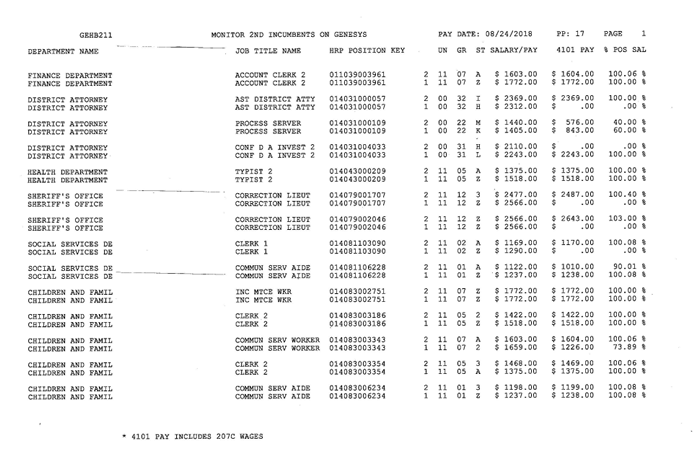
Mr. Jordan asked if service is split between two individuals, why a full-time position is being split rather than placed on the 103 line. Mr. Morgan said that he didn’t know if they are part time. He said that the hiring process for DA and Sheriff’s office doesn’t go through him. Chairman May said that at the end of the day they are double-encumbered positions.
9. COMPTROLLER: James Maturo, Deputy Comptroller/Accounting; Matthew Beadnell, Chief Gov. Accountant
a. Comprehensive Annual Financial Report
Mr. Maturo stated that Onondaga County issues a CAFR. The county is absolutely required to issue financial statements, which is a smaller report, but the CAFR includes a lot of other financial information helpful to legislature, taxpayers, bond rating agencies, etc.
Mr. Maturo:
- Letter of Transmittal, pg. III: designed to go to taxpayers of Onondaga County; gives a little bit of history, what is required to be done, and basically what is in the report; Factors Affecting Financial Condition – provided by CFO every year
- Opinion of outside auditors, pgs. VIII - X: Bonadio & Co., Inc., they review, audit, and issue their opinion.
- Have a clean opinion, which is what any organization strives for. It says that these statements reflect in all material respects the true operations of the county
- Management’s Discussion Analysis, pg. XI: more detail on the operations of the county in the current year
- Provides comparative information between this year and the prior year; a lot of good information that explains the difference in the operation from 2016 to 2017
- Debt assets/fixed assets
- Highlights of the operation of 2017
- Basic Financial Statement:
- Pgs. 1 - 4: Onondaga County at entity-wide level – on a full accrual basis. If Onondaga County were a business, this is how it would be reported. Incorporates all long-term debt and all fixed assets. At the fund level, debt is accounted for in the long-term debt group of accounts and fixed assets are accounted for in the fixed asset group of accounts. They are are not really part of the operations looked at the on the fund level.
- Fund Level:
- Pgs. 5 - 10: Shows Onondaga Co. at the fund level; level where the budget is adopted; each individual fund – general fund, WEP, debt service, capital projects; Other governmental funds: all smaller funds considered minor (detail in back of CAFR)
- Pgs. 5 & 6: balance sheet for funds
- Pgs. 8 & 9: operating statement
-
Proprietary funds – funds counted for as if they were a business
-
Pgs. 11 - 13: Internal Service fund is the self-insurance fund – all liability associated with it, i.e. long term workers comp, judgments & claims
-
Hotel Development Corp – new this year, a component unit deemed by GAAP
-
Trust & Agency Funds, pg. 14: veteran’s cemetery, a trust fund; pension fund is the NYS retirement; agency funds are other funds held by the county – county acts as trustee
- Component Unit Statements, pgs. 15 – 18: organizations so closely related to Onondaga County, that for Generally Accepted Accounting Principles, they have to be incorporated into county’s financial statements and report out on these organizations:
- Main component units are: OCC, OCDC, Fund Company (affiliated with Community Development), Friends of the Zoo, OCIDA
- OTASC and Housing Development Company – so closely tied into Onondaga County that GAAP requires that they be reported as if they are fund of the county
- Footnotes, pgs. 19 - 49: required information that needs to be presented, which explains the information in the front of the book, in entity-wide and fund level financial statements.
- Provides further breakdown
- Provides description of all of the county’s component units and why they are considered a component unit
- Provides information on debt, fixed assets, retirement benefits, commitments for Onondaga Lake
- Required Supplementary Information, pg. 50 : good information to have –budget to actual for each individual fund
Mr. Plochocki asked why it is labeled “unaudited”. Mr. Maturo explained that Bonadio does not express an opinion on the statements put in the back of the book. They certainly look at them, and certainly go through them. They are not expressing an opinion on them because it is stating Onondaga County operations on a budgetary basis. He said that there are some adjustments that they need to do to get the numbers to the front of the book. They are called Reclass and Elimination Entries for GAAP purposes – a whole slew of entries that gets them from budget basis to GAAP basis. The outside auditors’ opinion is based on GAAP basis, not so much the budgetary basis. Mr. Maturo reiterated that Bonadio most certainly reviews all this information. Mr. Plochocki asked if it is fair to say that this information is accurate. Mr. Maturo said “yes”. He added that it is actually the basis to get to the financial statements. In answer to Mr. Plochocki, Mr. Maturo clarified, that it is not just Bonadio – the required supplementary information is not audited by anyone. They are not expressing an opinion on those statements. He referred pages 50 and 51, general fund – ending the year in $7.7 million in deficit, but that is pretty much what was appropriated in fund balance. Mr. Maturo said “I say ‘deficit’; Mr. Morgan says ‘right on budget’.” In this case, that is exactly what happened -- $7.7 million was appropriated in fund balance and that is where we ended.
Mr. Maturo continued:
- WEP, pg. 52: used $3.9 million of fund balance; appropriated $7.7 million; a deficit of $3.9 million
- Retirement Plan/Post Employment Health Benefits, pg. 53: audited/unaudited figure – reports provided from NYS Retirement System; it comes from actuary, Armory Associates, for OPEB. It’s information that comes from a report – they don’t go in and audit those reports from Armory Associates and NYS, but they certainly review it
- Minor Funds, pgs. 55 – 58: not reported on face of the statement – reported on aggregate. This is where you see OTASC – coming in as a debt service fund
- Budget to Actual statements for minor funds, pgs. 59 – 70
- Statistical Section, pgs. 71 – 89: unaudited – information pulled together, 14 charts – a lot of good information – most of it shows 10 years’ worth of comparison: i.e. entity wide, fund level for 10 yrs.; top employers compared to 10 yrs. ago; top taxpayers compared to 10 yrs. ago; debt, property tax information
Mr. Maturo referred to paged 8 & 9 to review concerns from the Comptroller’s office after coming through the financial statements and where the numbers are at the end of the year. Last year the rating agencies and NYS Comptroller issued statements that they were concerned about the county’s reserves. He referred to the net change in fund balance, noting that it can be seen across the board that the reserves decreased again this year. If that was a concern last year, it’s got to be a concern this year – reserves are going down.
Mr. Maturo said that in the general fund, noting that we pretty much hit what the audited fund balance was, but the way it ties into the fund balance policy is that now we are below the 10% goal – 9.3% now. There are other commitments that need to be covered in the operations. Van Duyn, $2.5 million, will have to be closed out this year and absorbed within the general fund. He said that we will have to see how the operations go this year, as there was some money budgeted in for transfers.
Chairman May said it is important to footnote the concerns – the debt was as of December 31st. The forecast is different now – improved. They are very valid concerns and points, but at the same time, there is certain amount of calculated risk involved in accomplishing the things that we had to do. Mr. Maturo agreed, that the numbers were as of December 31, 2017. He said that we are onto 2018, we have realized more sales tax, ROT is up – as hoped it would be with the bowlers coming through.
Mr. Maturo said that another area of concern expressed by the NYS Comptroller was the county’s cash balance. The cash has dropped significantly from 2015, 2016, and 2017. He said that the County is down about $100 million in cash from where we were 12/31/15.
In answer to Mr. Jordan, Mr. Maturo said it is cash across all of the funds. He referred to pages 5 & 6 – noting that cash and equivalents is $112,207,968; there is some restricted cash of $27 million. He said that is the cash balance across all of the funds in the county at the end of each year. The general fund is 2015 reported $75 million in cash and we are down to $25 million this year. These are areas that anyone should be concerned with. They are areas of concern expressed last year with the results of 2016 and they have not improved.
Mr. Maturo referred to the fund balance policy, it is something to keep in mind going into the 2019 budget. The fund balance amount at 9.3% includes $5 million appropriated to the 2018 budget. Depending on where the operations are, we may not use any of it, but that’s in the 2018.
Mr. Jordan referred to cash being down and asked where in the report is it reflected – what the cash position was over the last 10 years. Mr. Maturo said that the balance sheet items are not included; what is included are the revenues, expenses, fund balance. However, he has all the information on the cash balances at the end of every year, which could be provided. Mr. Beadnell explained that you could look at the schedule on years past for this exact same pages and compare cash balances. Mr. Maturo said that his office can provide information on any balance. Mr. Jordan said that it might be helpful to have a similar chart showing historical information over the last 10 years. Chairman May suggested that 12 years be provided. Mr. Maturo asked Mr. Jordan if he wanted it by fund or in total. Mr. Jordan suggested both.
Mr. Fisher asked if deferred outflows could be included; stating that government balance sheets are hard to follow. He referred to page 1, Deferred Outflow of Resources, a year ago it was $138 million – it can represent things like grants where you haven’t completed the program. Mr. Maturo indicated that was incorrect and explained that deferred outflows are amounts that are due for the retirement system. He referred to page 25, which shows what the deferred outflows are at government fund level and then at the entity wide level. The biggest piece of it refers to NYS pension and how they report out what we owe them, what the assets have gained. He said it is pretty convoluted. It also includes the amount that the county treats as deferred for Environmental Facilities Corp purposes. Every year EFC issues debt, some is available to the county, but we haven’t spent it yet. It can’t be recognized as revenue to us; it has to defer until the expenses are actually made and then we can pull down those funds. Mr. Maturo said that he can provide the deferred outflows from previous years. Mr. Fisher said that it dropped $70 million from 2016 to 2017. Mr. Maturo said to take a look of the liability for NYS – it is all over the board.
Mr. Rowley referred to OPEB, Mr. Maturo said it is a like a pogo stick and ridiculous. He spoke to Bonadio to see if they had any insight into, which they did not know why that happens. Mr. Maturo referred to pg. 53, pension liability – in 2015 the liability was $29 million; the next year was $133 million; in 2017 $177 million. Chairman May said it is an actuarial function. Mr. Maturo said that OPEB is a little more straight forward; and when results are received, it what is believed to be expected.
Mr. Ryan asked about pension liability. Chairman May said that we have to reserve what we owe for pensions. Mr. Maturo said that at the entity wide level, we have to report our long-term liabilities. That is where the long-term piece for pensions comes in. That is the amount the county is going to pay from here to eternity for all of the people that have already retired, and what is believe to be the people that are going to retire from Onondaga County. There are a lot of actuarial computations that take place to come up with that figure. He said that even though we have a large liability, we only fund them on a pay-as-you-go basis. The same for OPEB – health and dental for retirees. The only thing we pay the retirement system is what they bill us for in the current year. Chairman May said that there is an accounting function that means we have to show it. Mr. Ryan said that even if it fluctuates, we still have to show something - it’s a major liability. Mr. Maturo agreed that we have to show the liability; but his frustration is how it can go from $29 million, to $133 million, down to $77 million.
Mr. Jordan referred to Schedule 1, Statistical Section, pg. 71 - total primary government net positions over 10 fiscal years -- it goes from $778 million down to $377 million. Mr. Maturo said that this the entity wide – includes all of the long term liabilities and fixed assets. When we first had to recognize OPEB liability for retirees, it could be accrued over a 20-year period. Every year, just based on that number, it’s going to go down, until it hits year 20. It’s expected to see that number drop, and see unrestricted go up because every year another $40 - $50 million is being plowed into that line because of recognizing that huge OPEB liability. It will be over $1 billion, over a period of 20 years. In the end, every municipality is going to be showing unrestricted net positions of billions of dollars. Mr. Maturo suggested that the better report to look at would be Schedule 3, pg. 75 – it shows the fund balances for the general fund, WEP, debt service, capital projects, and all of those other funds that are combined over the last 10 years.
Mr. Jordan referred to Schedule 3 and the total of all government funds was $35 million in 2008 and $4.2 million in 2017, a decrease of approximately $31 million. He said that he thought there was much more than than in terms of fund balance. Mr. Maturo said the funds represented in that number are the funds listed on pages 55 and 56 – grants, Oncenter, county roads, road machinery, water fund, Van Duyn, library, library grants, Community Development, OTASC. It is not a total of the first set of numbers. In answer to Mr. Jordan, Mr. Maturo said that there are major funds and minor funds. The minor funds are those just discussed reported in aggregate. The major funds are general fund, WEP, debt service, capital projects.
11. LAW DEPARTMENT: Robert Durr, County Attorney
a. Settlement of Claim
A motion was made by Mr. Jordan, seconded by Mrs. Ervin, to enter into executive session to discuss Klosure V. City of Syracuse and Onondaga County. Passed unanimously. MOTION CARRIED.
A motion as was made by Mr. Knapp, seconded by Mrs. Ervin, to exit executive session and enter regular session. Passed unanimously; MOTION CARRIED.
Chairman May stated for the record that no motions we made or action taken during executive session.
The meeting was adjourned at 12:10 p.m.
Respectfully submitted,

DEBORAH L. MATURO, Clerk
Onondaga County Legislature
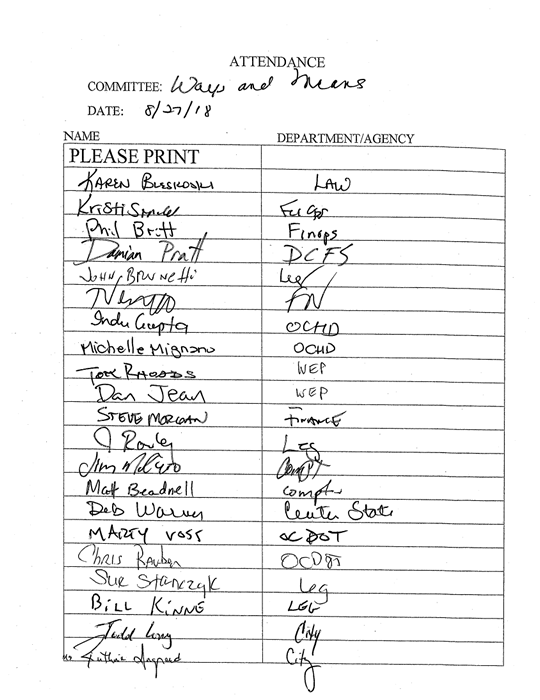
|




























































